“PELPOP” – The Story of Pelham Puppets
by David Leech – Authorised Historian for Pelham Puppets
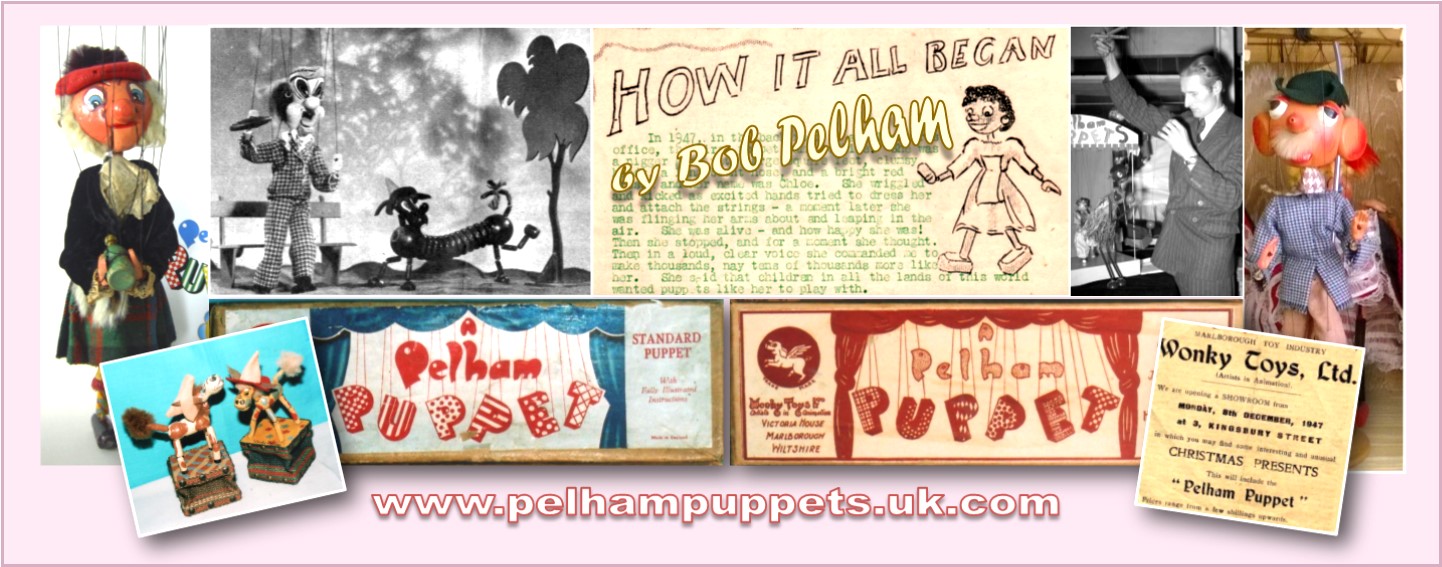
These two pages present highlights about the History & Development of Pelham Puppets from 1947 to 1980. I have updated the contents with some never before published photographs that were intended to be included in the book in 2008, but editing requirements meant lots of information was left out. The idea for writing the story began one evening in November 1973 while staying in Mr Pelham’s house, chatting with him and not realising at the time, that I was sitting in his favourite armchair!
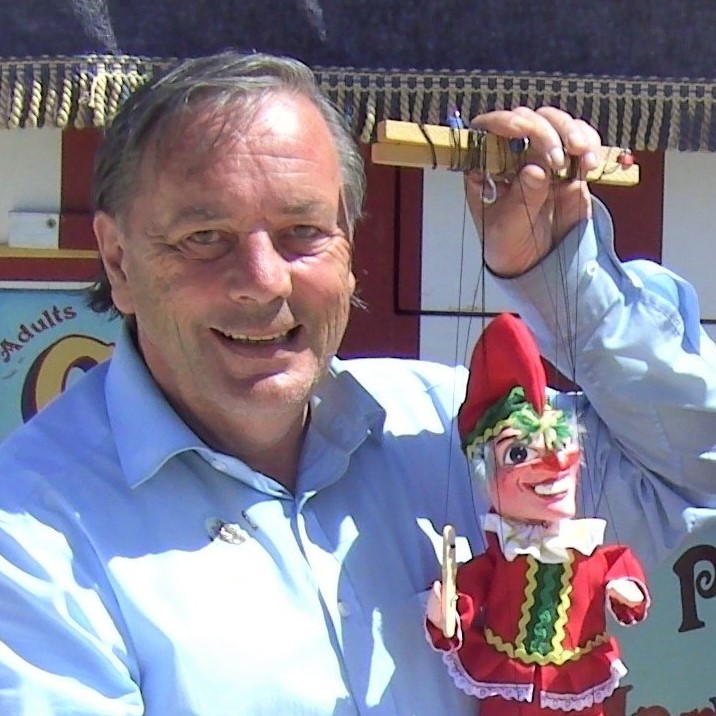 Less than two years later I was working part-time, every week, in the puppet factory, until I was able to move near to Marlborough and work there full time. Most of the information is the result of daily conversations with Bob Pelham and many of the factory employees during the 1970’s as well as extracts from Pelpup News magazines and newspaper articles. I wrote and researched the story with the full approval of both Mr and Mrs Pelham who were very kind and generous to me and my family. I hope you enjoy reading it as much as I have writing it. Writing this story has actually become a very enjoyable and major part of my life for over 50 years! David Leech, May 2020.
Less than two years later I was working part-time, every week, in the puppet factory, until I was able to move near to Marlborough and work there full time. Most of the information is the result of daily conversations with Bob Pelham and many of the factory employees during the 1970’s as well as extracts from Pelpup News magazines and newspaper articles. I wrote and researched the story with the full approval of both Mr and Mrs Pelham who were very kind and generous to me and my family. I hope you enjoy reading it as much as I have writing it. Writing this story has actually become a very enjoyable and major part of my life for over 50 years! David Leech, May 2020.
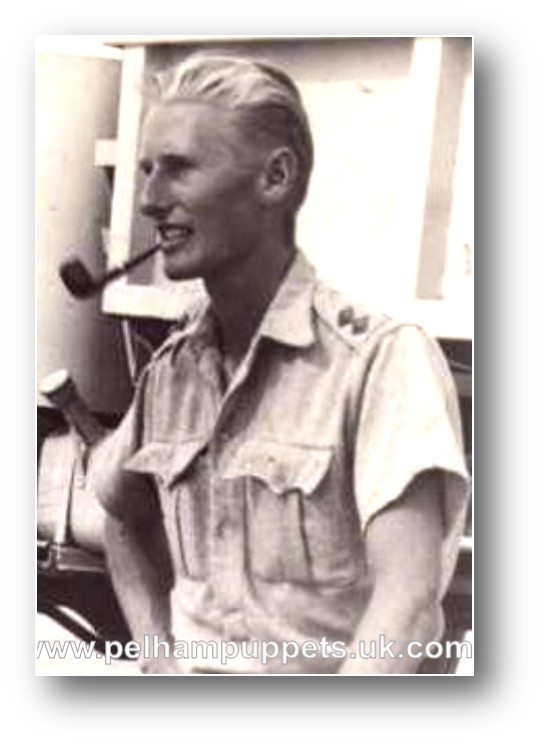
Part One. How It All Began.
Creating toys wasn’t something Bob Pelham even thought of before the war years, he had intended to return to college as his father would have wished. “I’m not sure when I had the idea for making puppets but while I was in Germany at the end of the war I became known as the ‘Wonky Donkey Officer’ because I used to make little donkeys using wooden beads that could be made to wriggle and dance by strings attached to a small spring base. When I returned home, I simply couldn’t go back to drawing dull old buildings. I wanted to create something that’s as near to being alive as makes no difference.”
It wasn’t long before he had rented a workshop behind a solicitor’s office in Silverless Street, Marlborough and began to design and create the amusing little figures that had proved so popular with the troops. “I designed them around the materials available at the time, using whatever materials and parts I could obtain locally. Once I had made a few dozen, I set up a small sales stall at nearby horse racing courses and sold them there.”
As sales increased, Bob started to look for people to help with producing the little figures. At this time, Dennis Clements, was the gardener for Bob’s father, Walter Pelham. He put Bob in touch with Frank Clements, (unrelated) and Sid Hiscock and they both accepted offers of work right away. Bob then took on two other people, Laura Ray and Rosemarie Gibaud. Bob said, “Laura had been housekeeper for my parents for a few years and after my father retired, he suggested I invite her to come and work for me. Rosemarie came to work for me after I met her in a tea shop where she worked in Marlborough. She was a good artist and she had intended to study dress design in France, but the war put a stop to her plans.”
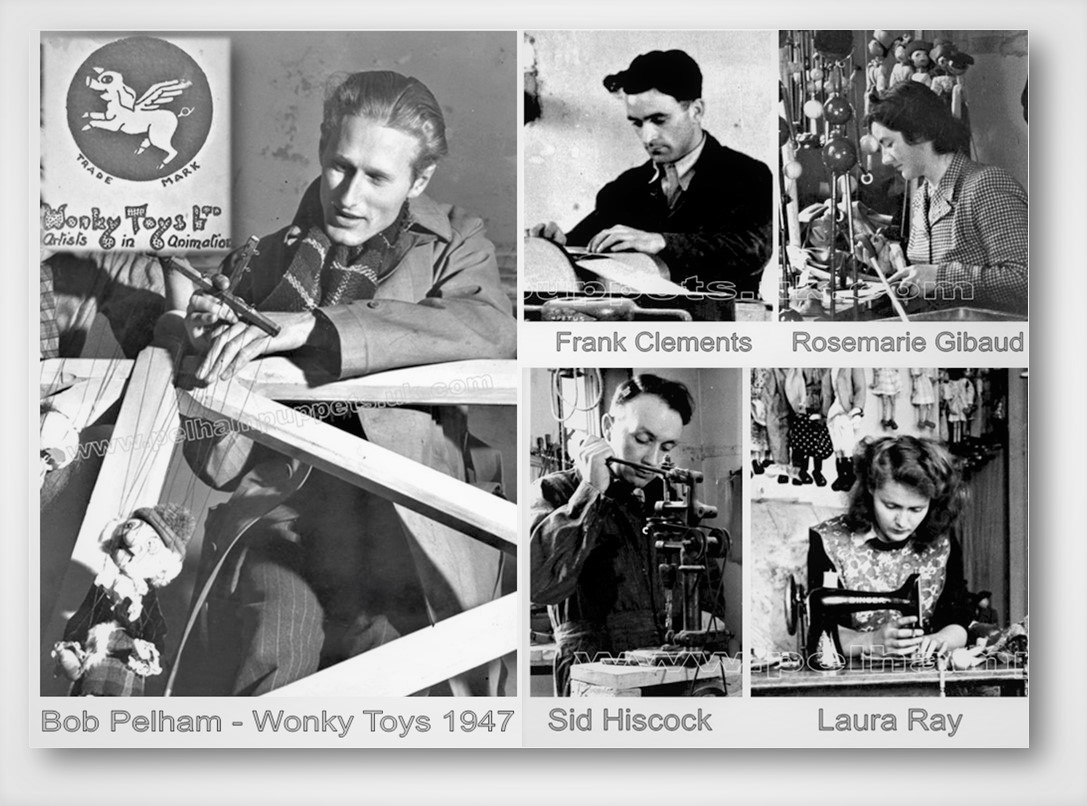 In a very short time this small team began producing a regular and increasing number of donkeys, giraffes, elephants and ostrich animated toys.
In a very short time this small team began producing a regular and increasing number of donkeys, giraffes, elephants and ostrich animated toys.
Walter (‘Watty’) Pelham was the Rector of Chilton Foliat, (and a JP from 1925 to 1945.) Dennis recalls that when Walter retired, he helped his son during that first year and his support became very evident when Bob encountered a serious problem soon after starting up the Wonky Toys business.
Another toy manufacturing company claimed that they held the manufacturing rights to these figures and Bob received notice from this Company telling him he must stop production or face legal action if he did not clear his stock by a particular date. At the time, he felt there was no alternative but to abandon production and they moved over to creating the puppets.
Dennis recalls, “Unfortunately, Bob had put all his money into the Wonky Donkey venture and so had little in the way of capital to begin the new enterprise with. At the time, Walter had two cars and seeing how determined and enthusiastic his son was, in setting up the puppet business, and unfazed by the setback with the Wonky Toys, Walter sold one of the two motor cars for £130. “Well, Dennis, I’ve done it! I’ve handed him the cash, but he won’t make a go of it – if he organised a children’s tea party, he’d probably forget the buns!” (Dennis also recalled that Bob’s mother, Ruth Pelham, was a kind and generous person with a good sense of humour too. “We would sometimes find small, unexpected gifts in our coat pockets at the end of a working day. One Christmas, she bought us all an alarm clock each, “to make sure we got up in time to go to work!””)
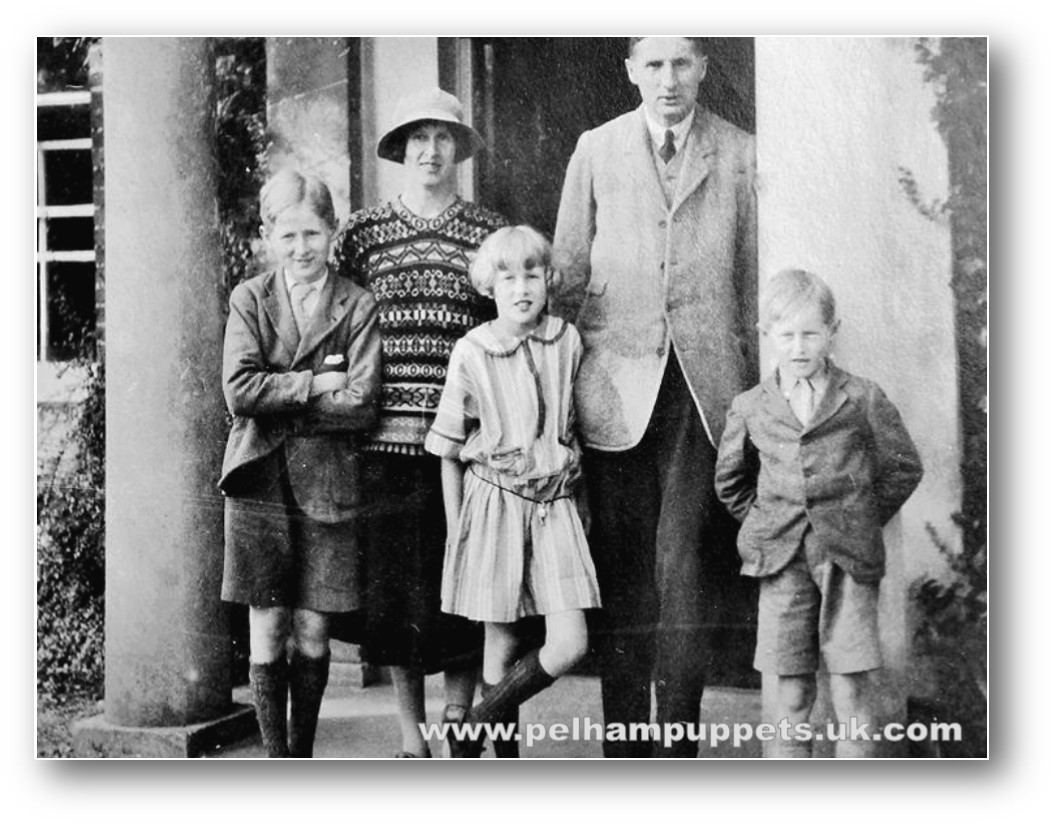
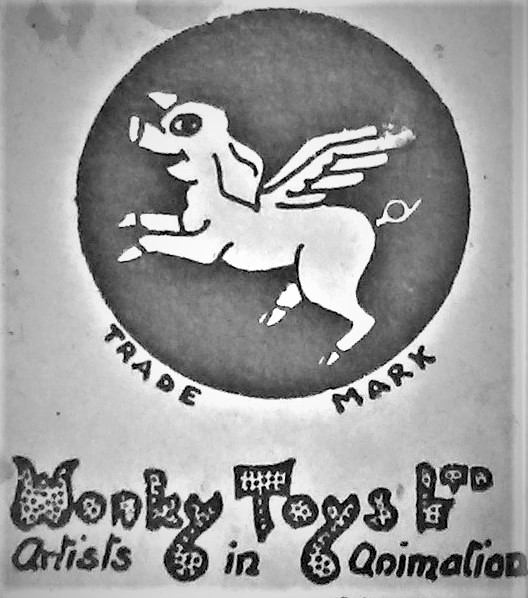 The photograph above is from the Pelham Family album, taken in 1926 in Chilton Foliat, Wiltshire. From left to right: Bob’s brother, Tom, age 11; his mother, Ruth; his sister, Patricia, aged 9; his father, Walter and young Bob Pelham aged 7. (I extend my sincere thanks to Bob Pelham’s nephew, David, for giving me permission to include and publish this photograph.)
The photograph above is from the Pelham Family album, taken in 1926 in Chilton Foliat, Wiltshire. From left to right: Bob’s brother, Tom, age 11; his mother, Ruth; his sister, Patricia, aged 9; his father, Walter and young Bob Pelham aged 7. (I extend my sincere thanks to Bob Pelham’s nephew, David, for giving me permission to include and publish this photograph.)
Dennis went on to relate, that when his father gave the money to Bob he told him, “If you make this business work, pigs will fly!” Reflecting Bob’s confidence and sense of humour, (which he evidently inherited from his mother,) he created a company logo of a flying pig and it appeared on the puppet boxes for nearly ten years!
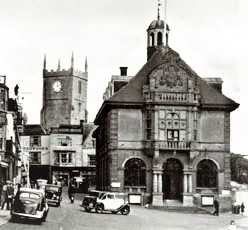 However, Bob had been left with the problem of clearing the existing stock of Wonky Toys. The deadline for clearance was long before Christmas, when they would have sold well, so the decision was taken for the Wonky Donkeys to be sold at the Marlborough Mop Fair which has been held for many years by Ancient Charter in the very wide High Street of Marlborough. It is an annual fair and is held on two Saturdays in October. Bob and his employees soon got ready. He hired a covered stall and obtained a pitch in front of the Town Hall, where his name was painted on the roadway in traditional style. He had obtained a peddler’s license for himself and his two assistants, Rosemarie and Laura. Sales were good on the first Saturday of the fair and the fairground folk, intrigued by the new, young stallholder and his blonde and brunette assistants, gave them plenty of support once they heard their story. (Left: Town Hall Marlborough)
However, Bob had been left with the problem of clearing the existing stock of Wonky Toys. The deadline for clearance was long before Christmas, when they would have sold well, so the decision was taken for the Wonky Donkeys to be sold at the Marlborough Mop Fair which has been held for many years by Ancient Charter in the very wide High Street of Marlborough. It is an annual fair and is held on two Saturdays in October. Bob and his employees soon got ready. He hired a covered stall and obtained a pitch in front of the Town Hall, where his name was painted on the roadway in traditional style. He had obtained a peddler’s license for himself and his two assistants, Rosemarie and Laura. Sales were good on the first Saturday of the fair and the fairground folk, intrigued by the new, young stallholder and his blonde and brunette assistants, gave them plenty of support once they heard their story. (Left: Town Hall Marlborough)
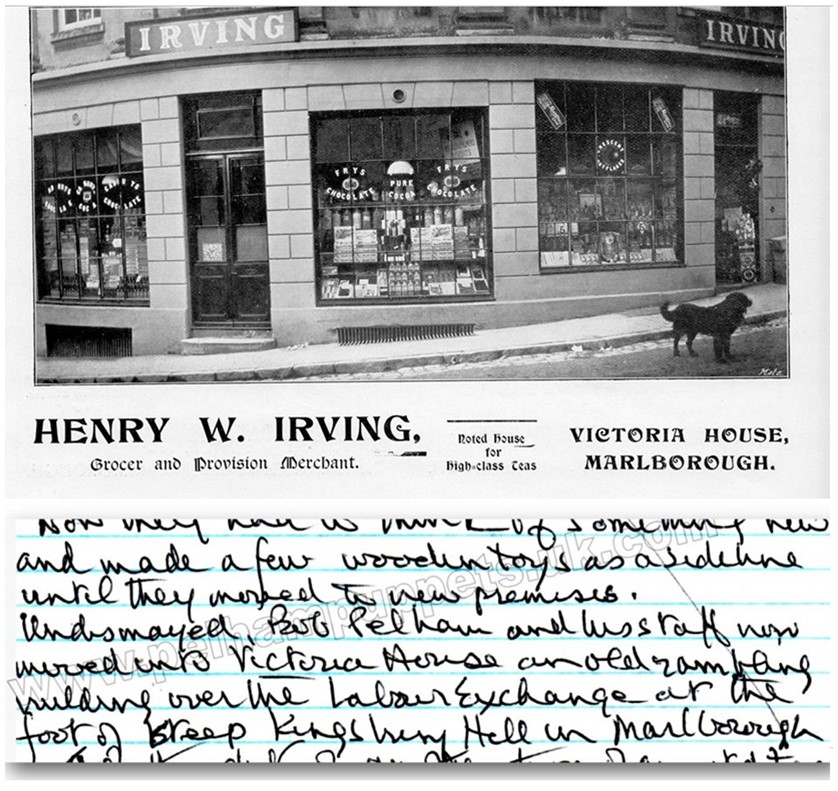 It was an exciting time for the young ‘Artists in Animation,’ selling their wares by daylight and lamplight, amongst the noise and music of the sideshows and carousels. They worked all day and into the night and it succeeded. The stock was cleared with a reasonable profit. After that, as Rosemarie recalls, “We made a few wooden toys as a side-line until we moved into Victoria House, an old rambling Building over the Labour exchange at the foot of Kingsbury Hill in Marlborough.” The building was known locally as Victoria House and Irvine’s, a grocer’s shop occupied the ground floor prior to the war, as can be seen from the advert in the Marlborough Times here. The puppet making workrooms were situated on the first floor of the building and Bob also had a shop next door at number 3 Kingsbury Street. Since the ground floor was occupied by the Labour Exchange following the 2nd World War.
It was an exciting time for the young ‘Artists in Animation,’ selling their wares by daylight and lamplight, amongst the noise and music of the sideshows and carousels. They worked all day and into the night and it succeeded. The stock was cleared with a reasonable profit. After that, as Rosemarie recalls, “We made a few wooden toys as a side-line until we moved into Victoria House, an old rambling Building over the Labour exchange at the foot of Kingsbury Hill in Marlborough.” The building was known locally as Victoria House and Irvine’s, a grocer’s shop occupied the ground floor prior to the war, as can be seen from the advert in the Marlborough Times here. The puppet making workrooms were situated on the first floor of the building and Bob also had a shop next door at number 3 Kingsbury Street. Since the ground floor was occupied by the Labour Exchange following the 2nd World War.
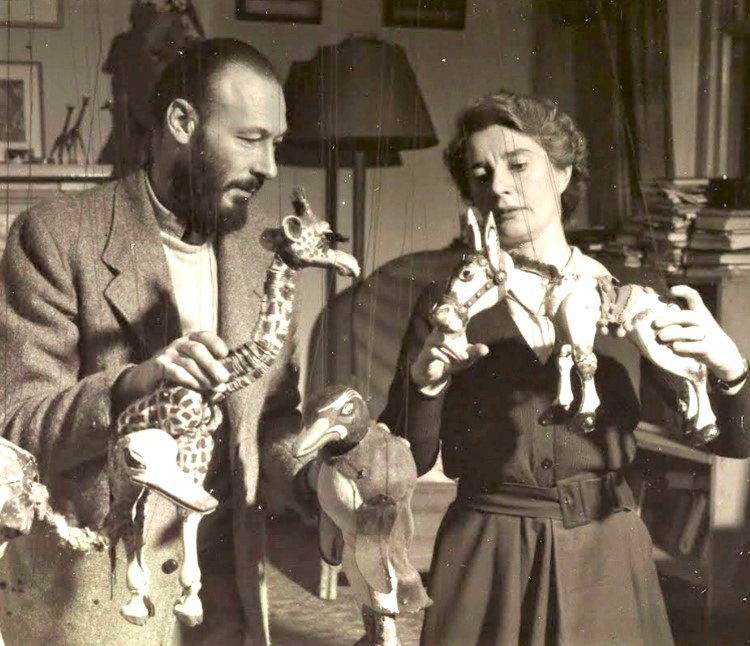 With no previous experience with puppets he enlisted the help of Jan Bussell and Ann Hogarth who lived across the street from where he had his workshop, seeking some help and advice in the design and construction of string puppets. Jan was only too happy to assist and recalled how Bob approached him with the idea of manufacturing puppets and he worked out details of the simplest form of control and stringing with him. “Jan gave encouragement and advice at a time when it was most needed,” Bob said, and he found it gratifying to feel, “that so much fun was being given to so many by something which, at one time was considered unsaleable.” (Photo: Jan Bussell and Ann Hogarth in their home in Marlborough. Courtesy of Will McNally.)
With no previous experience with puppets he enlisted the help of Jan Bussell and Ann Hogarth who lived across the street from where he had his workshop, seeking some help and advice in the design and construction of string puppets. Jan was only too happy to assist and recalled how Bob approached him with the idea of manufacturing puppets and he worked out details of the simplest form of control and stringing with him. “Jan gave encouragement and advice at a time when it was most needed,” Bob said, and he found it gratifying to feel, “that so much fun was being given to so many by something which, at one time was considered unsaleable.” (Photo: Jan Bussell and Ann Hogarth in their home in Marlborough. Courtesy of Will McNally.)
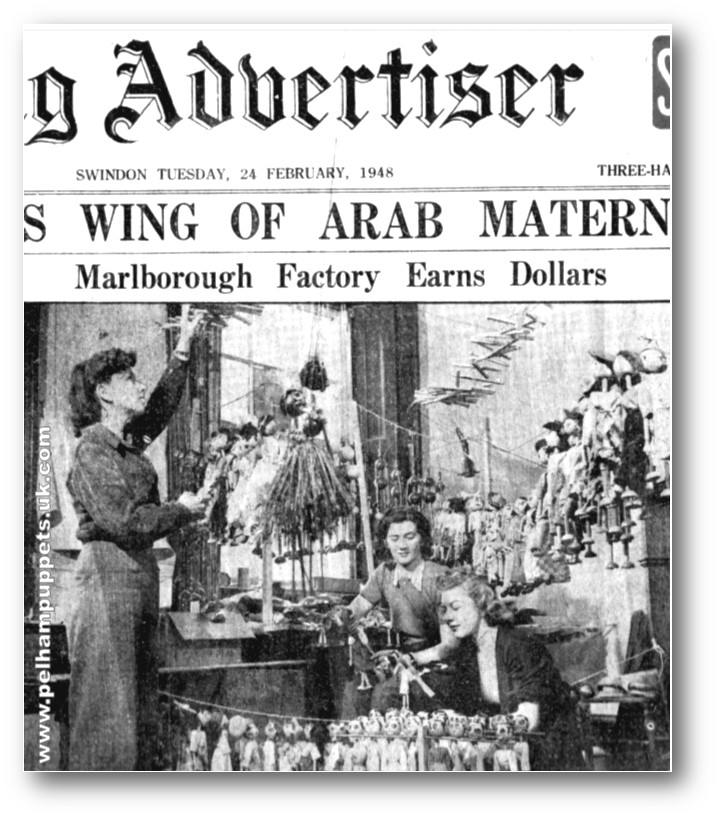
During the winter of 1947 snow fell almost daily and the frosts each night kept the snow deep and crisp for about six weeks. Often the electricity supply was cut off for several hours in the daytime to conserve it for the public needing light and heat during the nights. Bob’s concern for the welfare of his employees moved him to take unusual steps to ensure they had a measure of comfort. He recalled that at his home, in the stables, stood an old heating stove in the harness storeroom. He dismantled it and took it to Victoria House where it was soon reassembled and glowing merrily on a diet of odd bits of wood and anything else they could find for fuel, as coal was still rationed at that time.
They frequently experienced frozen water pipes too, but the ingenuity of this group of workers was not only confined to puppet making. Dot Mercer and Frank Clements daily carried a milk churn down Kingsbury Hill from her home, looking like Jack and Jill in the nursery rhyme but hoping that they would not tumble down the steep icy slopes! With their help, water was available for hot drinks and other needs. The stove boiled kettles, glue pots and even roasted chestnuts!
During the first year, Bob and his employees were sorting, sawing, drilling, gluing and painting an assortment of waste materials into fully jointed puppets of remarkable individuality. This was in fact, one of the most interesting features about the infancy of the business. The puppets were made entirely from recycled materials.
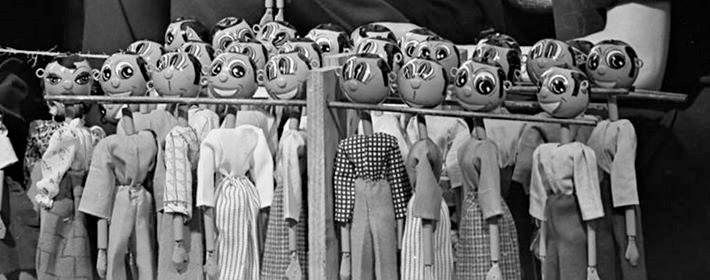
Victoria House was certainly an extraordinary place to work. The unusual product they were manufacturing and the happy family atmosphere, created a feeling of group endeavour that formed the basis of the company for years to come.
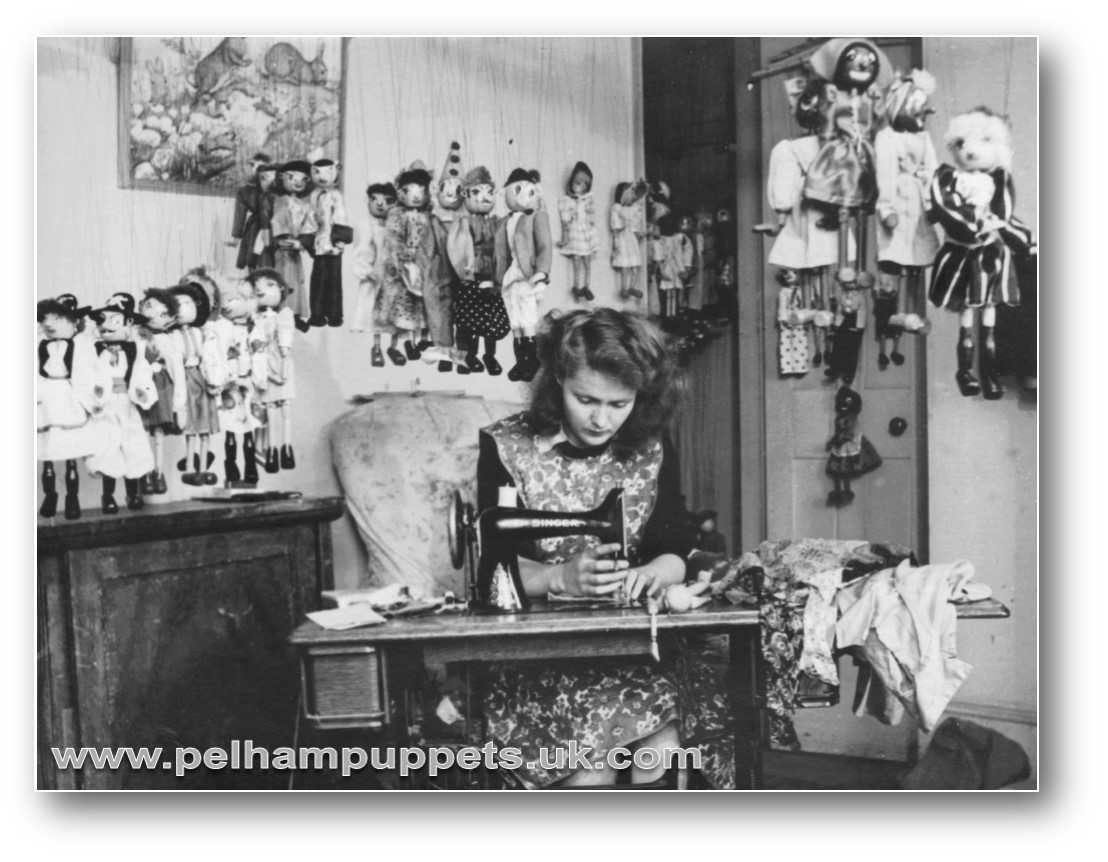 Laura Ray sewing puppet costumes in Victoria House 1947
Laura Ray sewing puppet costumes in Victoria House 1947
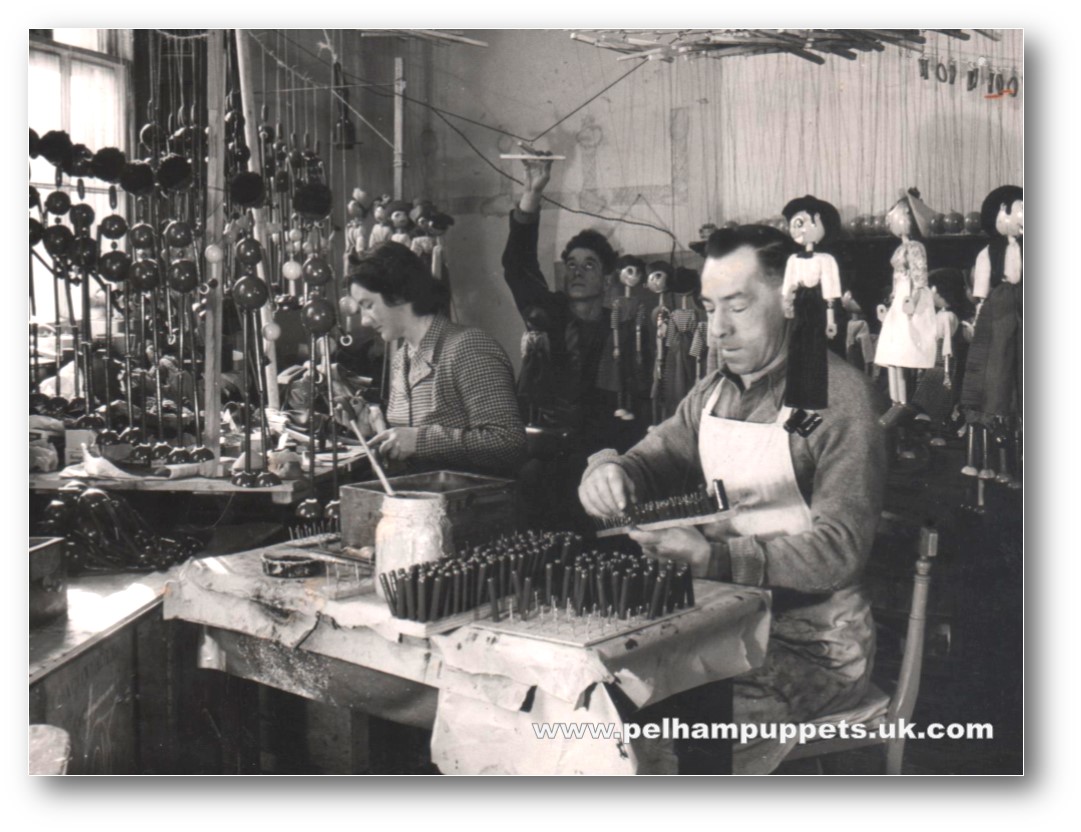 Left to Right: Rosemarie Gibaud, Sid Long and Charles Warren
Left to Right: Rosemarie Gibaud, Sid Long and Charles Warren
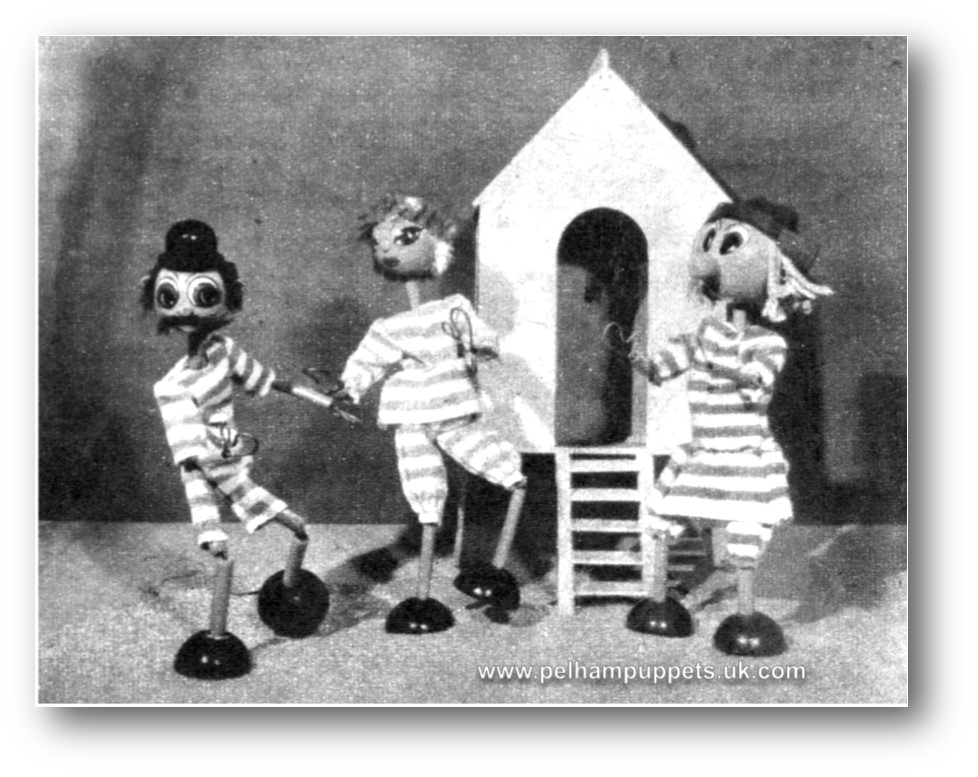 “Bendipups” Static puppet figures for display purposes.
“Bendipups” Static puppet figures for display purposes.
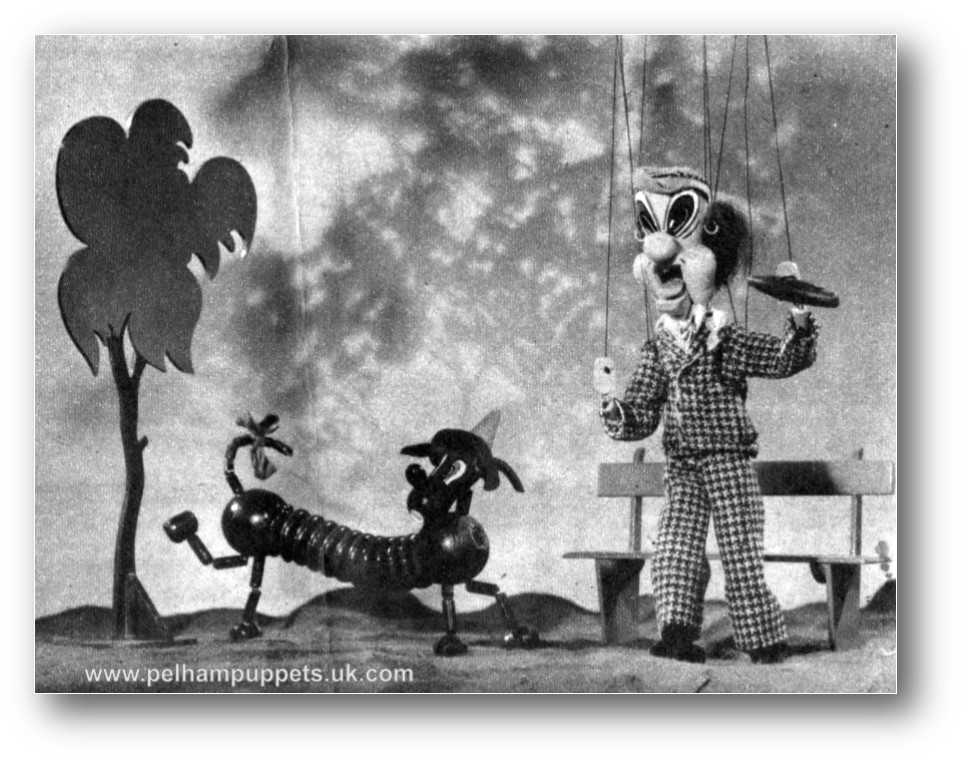 An early Dachshund and “Honest Joe”.
An early Dachshund and “Honest Joe”.
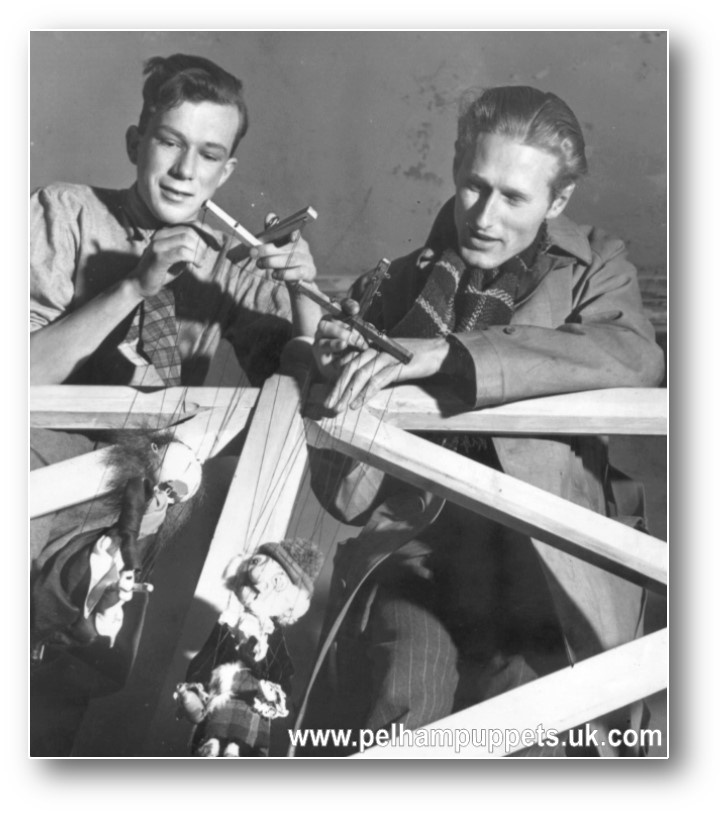
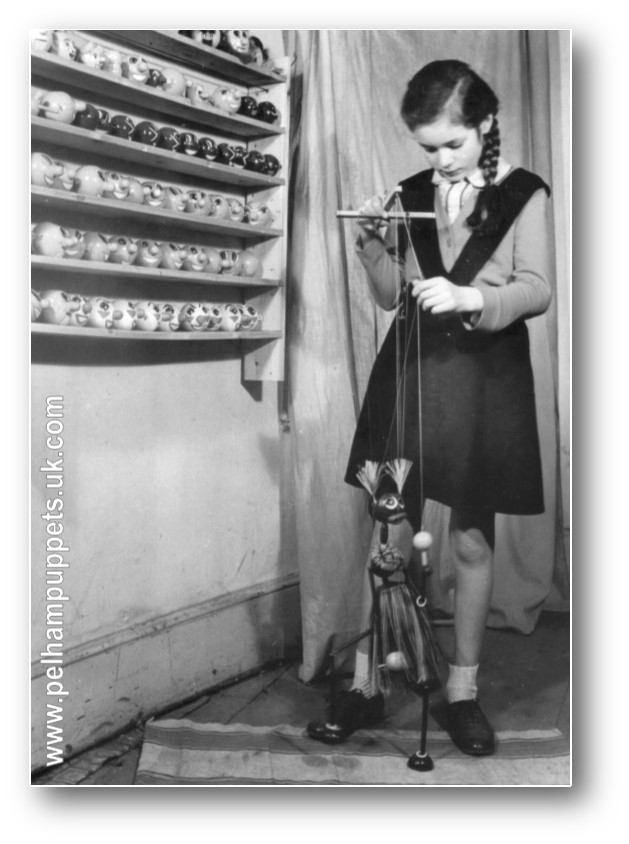
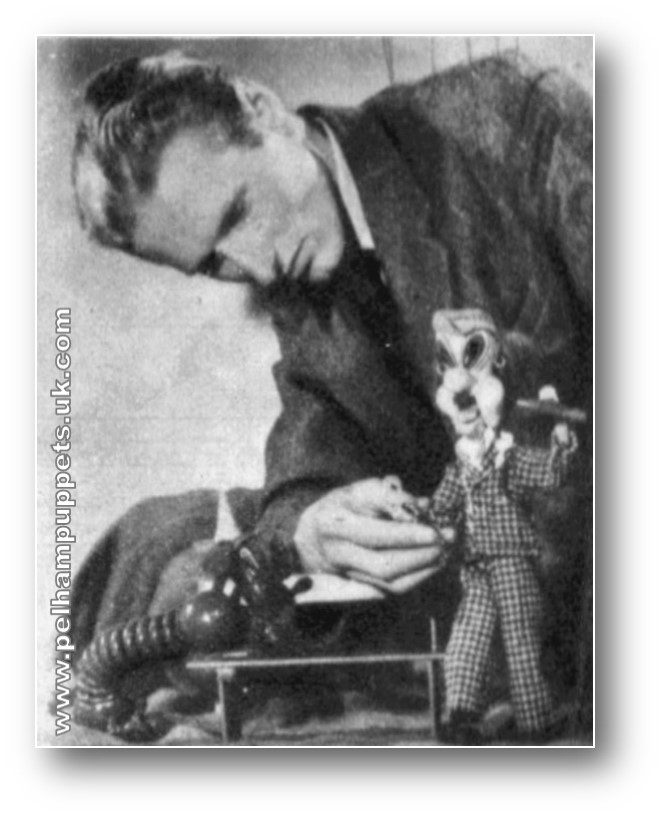
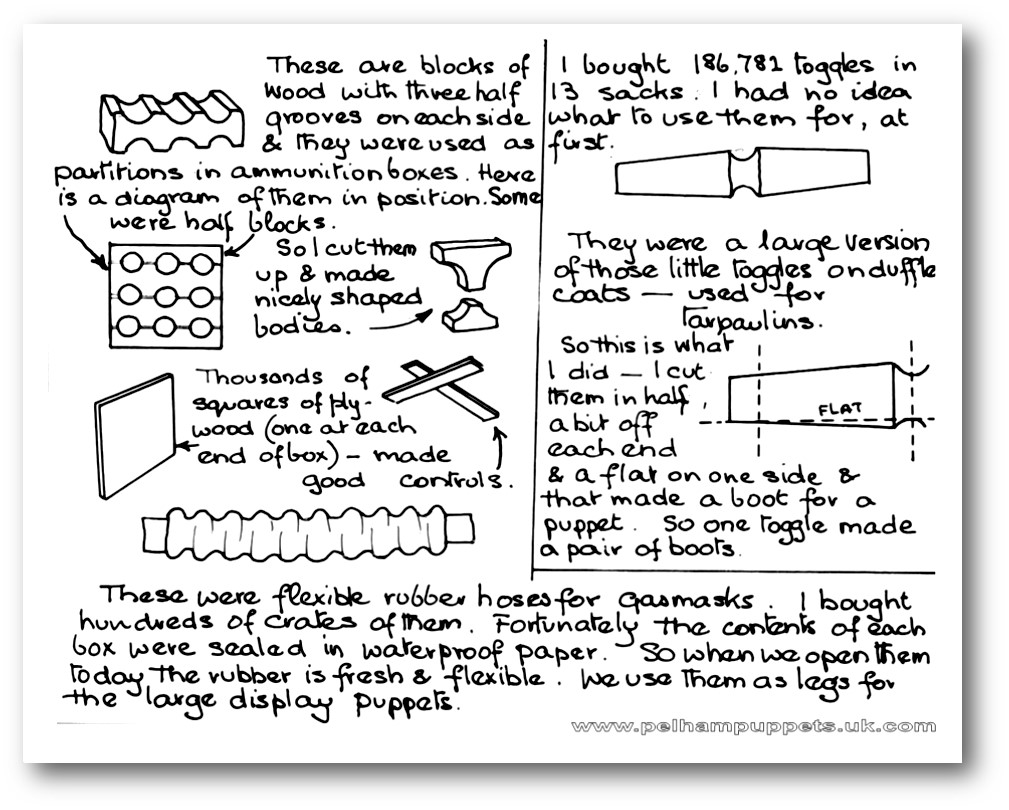 “When I first started making puppets, I used to spend hours rummaging through Bert New’s Scrap yard, looking for anything that might prove useful, doorknobs, loose banister rails, bits of carpet, nothing was safe! No wonder my poor father wished I would get back to architectural college and learn a useful profession! I also had a friend, a former Army comrade in Bristol who managed a Government Surplus Depot and he used to send me tenders for such things as ammunition partitions, pieces of plywood, toggles, rubber respirator tubes even parachutes. If the shape looked hopeful, I would buy them up. I never paid very much because there were few others interested! I’d then try and decide what to use them for.
“When I first started making puppets, I used to spend hours rummaging through Bert New’s Scrap yard, looking for anything that might prove useful, doorknobs, loose banister rails, bits of carpet, nothing was safe! No wonder my poor father wished I would get back to architectural college and learn a useful profession! I also had a friend, a former Army comrade in Bristol who managed a Government Surplus Depot and he used to send me tenders for such things as ammunition partitions, pieces of plywood, toggles, rubber respirator tubes even parachutes. If the shape looked hopeful, I would buy them up. I never paid very much because there were few others interested! I’d then try and decide what to use them for.
For example, the unique looking wooden feet used on the standard puppets started life as tarpaulin toggles, as Bob once related: “One day I made an offer for 186,742 toggles. At first, I hadn’t any idea what to use them for, but they looked like the sort of shape that should be useful. I paid £15 for them and was horrified when about twenty sacks were dumped in the doorway of my then, small premises. Being a stickler for getting my money’s worth, I counted out 100 and weighed them. I then set this against the total weight and arrived at a figure of 185,327. I wrote back saying I was 1,415 short and if they couldn’t find them would they please send me the appropriate refund. Would it surprise you if I said, I didn’t get a reply?”
It was in January 1947 that Sid Long knocked on Bob’s door and announced, “I’ve come to help!” Formally of the 2nd Battalion of the Wiltshire Regiment, he was severely wounded in Germany during the last week of the war, when he and several other soldiers were attacked and hit by anti-tank weapons. He lost a leg in addition to other injuries, so he was unable to return to his former work in the building trade. Bob explained to Sid that due to the very bad winter weather it would be better to wait until the weather improved. He started on 7th March 1947 and he became very skilled at stringing especially and often created splendid hats for the puppets too. He remained at Pelham Puppets until his retirement in 1977. Below we see Sid in left photograph assembling a puppet in 1948 centre photograph he is stringing puppets and on the right, Mr Pelham presented him with an engraved tankard at the time of his retirement in 1977. Sid was a great asset to the Company, as Bob once said, “He can do just about anything!”

The women painted faces and made costumes on an aged sewing machine or by hand in their homes. Before the end of 1948, the number of employees increased considerably. Edna Rumbold, and Dot Mercer joined the Company in the summer and Joan Brown arrived in the October. Joan went on to become Forewoman until her retirement in October 1980. Doris Birley and Eileen Sims-Neighbour arrived on the same day in November 1948. Eileen also became a regular demonstrator and head of the stringing department and Doris became the leading lady in hand sewing the costumes. Doris remained with the Company until her retirement in July 1980.
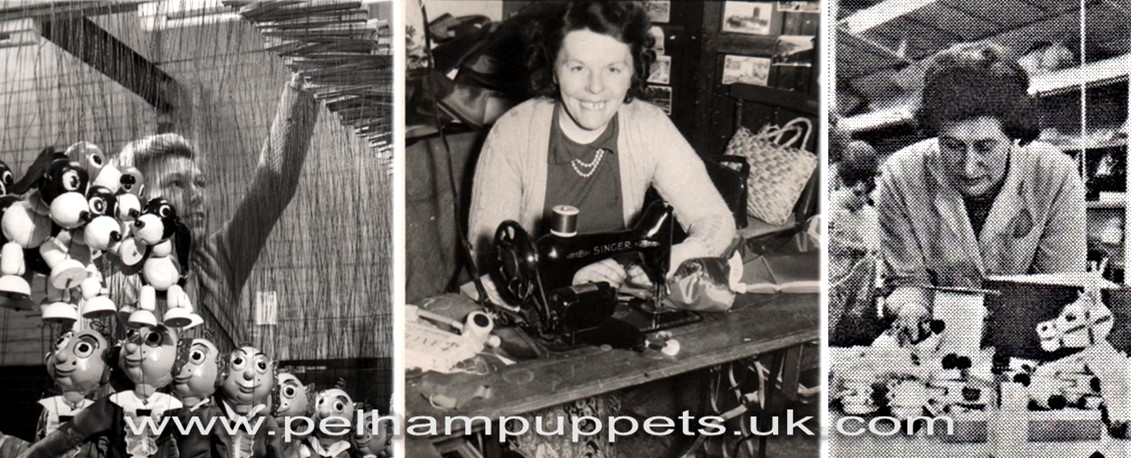
Photo: Eileen stringing Mr Turnips, Doris sewing and Joan the forewoman
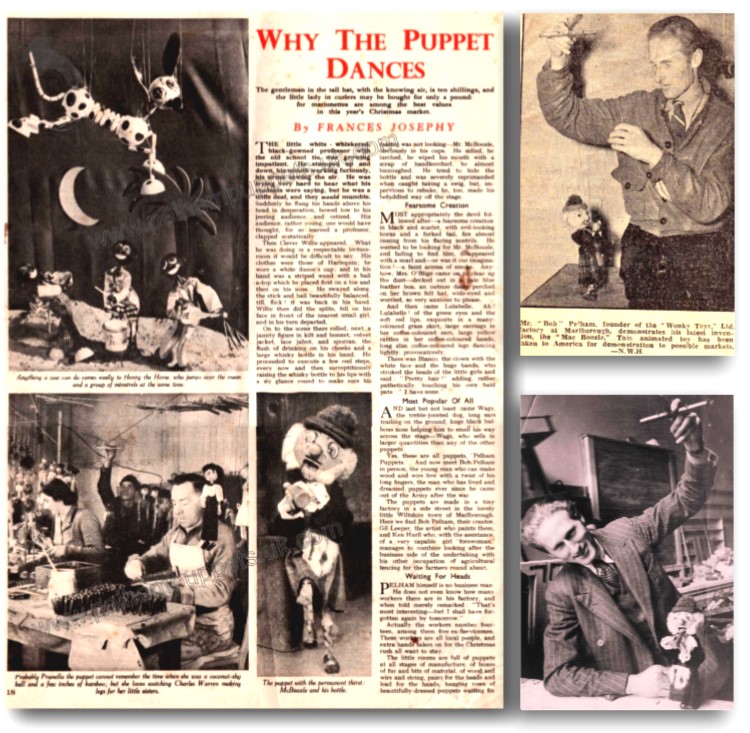 Puppet production was very experimental since no-one else had ever tried producing puppets for the Toy Trade and for children to play with. A wide variety of characters were created and naturally, some would go on to become very popular, such as Wags the dog and the standard “pairs” depicting different nationalities, such as the Dutch Boy & Girl remained in production for the next 40 years! This new, exciting venture certainly captured the imagination of the public and Bob was often featured in the local and national press and on the new medium of television with one of his favourite characters, Sandy MacBoozle. He was filmed at the British Industries Fair and was featured in a number of national newspapers, including the Daily Mirror on 30th December 1947, the London Recorder on 10th January 1948 and Everybody’s Weekly on December 17th, 1949.
Puppet production was very experimental since no-one else had ever tried producing puppets for the Toy Trade and for children to play with. A wide variety of characters were created and naturally, some would go on to become very popular, such as Wags the dog and the standard “pairs” depicting different nationalities, such as the Dutch Boy & Girl remained in production for the next 40 years! This new, exciting venture certainly captured the imagination of the public and Bob was often featured in the local and national press and on the new medium of television with one of his favourite characters, Sandy MacBoozle. He was filmed at the British Industries Fair and was featured in a number of national newspapers, including the Daily Mirror on 30th December 1947, the London Recorder on 10th January 1948 and Everybody’s Weekly on December 17th, 1949.
Johnny Bunce and the “Four Balls for 6d!”
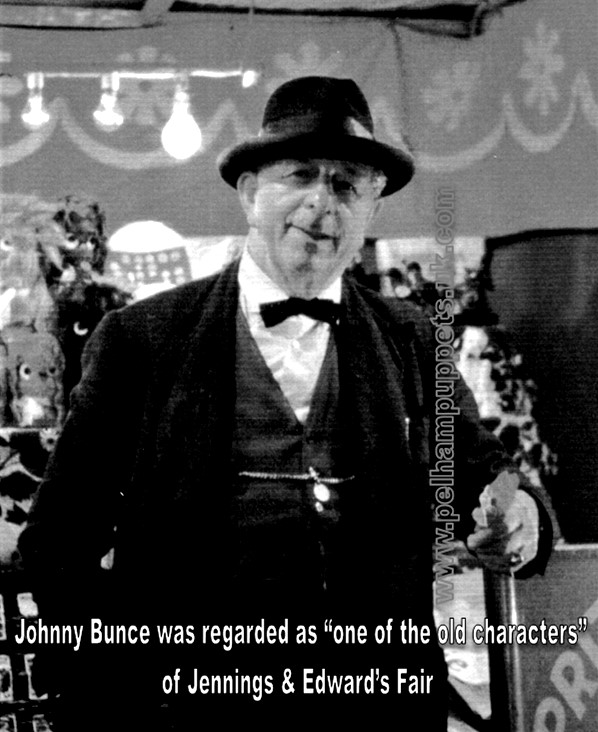 It was in October 1947 that MacBoozle also played an important part in the development of the manufacture of the puppets. It was an event that proved to be a turning point in the history of Pelham Puppets. During the first year or two Bob had difficulty making puppet heads. He explained, “At first, we turned them on a lathe, but they all came out in different shapes from ovals to squarish rounds. Well, I suppose it did mean their heads were all different shapes but as we wanted them in large quantities an alternative supply had to be found. So, imagine my delight when one day during the Mop Fair in Marlborough High Street I came across a large box of the roundest wooden balls I had ever seen. “Four balls for sixpence!” the man said, thrusting them into my hands.” That man was Mr Johnny Bunce.
It was in October 1947 that MacBoozle also played an important part in the development of the manufacture of the puppets. It was an event that proved to be a turning point in the history of Pelham Puppets. During the first year or two Bob had difficulty making puppet heads. He explained, “At first, we turned them on a lathe, but they all came out in different shapes from ovals to squarish rounds. Well, I suppose it did mean their heads were all different shapes but as we wanted them in large quantities an alternative supply had to be found. So, imagine my delight when one day during the Mop Fair in Marlborough High Street I came across a large box of the roundest wooden balls I had ever seen. “Four balls for sixpence!” the man said, thrusting them into my hands.” That man was Mr Johnny Bunce.
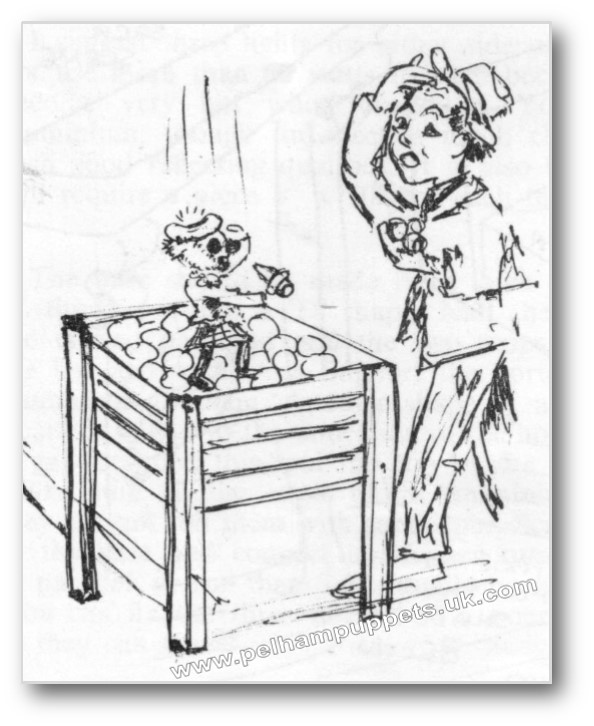 Johnny Bunce was regarded as “one of the old characters” of Jennings & Edward’s Fair that first appeared in Marlborough in 1947. He had the coconut shy that was situated “about where the old cinema used to be.” He was a well-built gentleman and always wore an old hopper hat and a waistcoat with a watch & chain and was also known as a man who “did a bit of buying and selling and good at bartering and all sorts of things – he always had something in his pockets to make a bob or two.”
Johnny Bunce was regarded as “one of the old characters” of Jennings & Edward’s Fair that first appeared in Marlborough in 1947. He had the coconut shy that was situated “about where the old cinema used to be.” He was a well-built gentleman and always wore an old hopper hat and a waistcoat with a watch & chain and was also known as a man who “did a bit of buying and selling and good at bartering and all sorts of things – he always had something in his pockets to make a bob or two.”
Bob went on to tell him, “these are just what I want! Where did you get them from? But he wouldn’t tell me – I suppose he thought I was going to set up another coconut-shy stall. So, I went off and fetched MacBoozle and got him to leap up onto the box of balls by the stall, made him tap his head and say, “This is what he wants these balls for!” At that, Mr. Bunce became very friendly and he readily gave the name of some woodturners, Hoopers of Stroud.
Eric Brown was the owner of an Ironmongers shop in Marlborough High street at the time. He recalls meeting Bob Pelham at the 1947 Mop Fair, “He was selling off his Wonky Toys in front of the Town Hall with two ladies. They had a little stall and they were demonstrating how the Wonky Donkeys moved. I remember I stood next to him when he went to the coconut shy and asked the guy where he got them from. He then ran off and came back with a puppet and, as far as I know, that was the absolute start of Pelham Puppets. I did business with him for several years after that, when he became established and he used to buy all the hooks and eyes that were used for curtain wire. He would sometimes come into the shop with his bulldog. He seemed a very shy man, almost embarrassed in the early days. He was a slow and quiet speaker and he used to stutter a little. He was a very nice, quiet individual.”
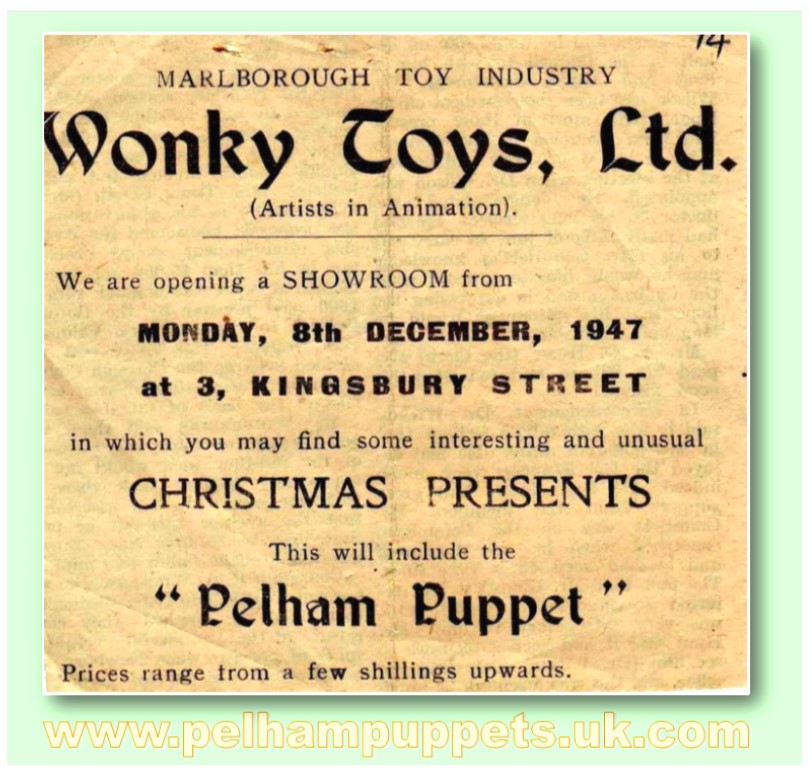 At first, the only outlet for puppet sales consisted of a window display and the shop at the bottom of Kingsbury Street. As the Christmas season drew near, daily demonstrations were staged in the window much to the delight of passers-by. Bob advertised in the local press and this advertisement appeared in the Marlborough Times on 5th Dec. 1947.
At first, the only outlet for puppet sales consisted of a window display and the shop at the bottom of Kingsbury Street. As the Christmas season drew near, daily demonstrations were staged in the window much to the delight of passers-by. Bob advertised in the local press and this advertisement appeared in the Marlborough Times on 5th Dec. 1947.
“I sold a good number of puppets to my friends and to their friends because they were immediately convinced that they were simple to work and ideal for children,” he said, “I knew I would have to persuade the large stores to take them if the business was to expand. At first, not a shop in the land would take them! It seemed people had never heard of puppets before. “Puppets?” they would say, “What are puppets?” “But I just knew that children would like them it just wasn’t easy getting that across to adults.” Despite such discouraging experiences, Bob’s perseverance, enthusiasm and confidence were eventually rewarded. “Eventually, I persuaded Hamleys in Regent Street to let me demonstrate them myself behind a counter. So, there I was, for three weeks, demonstrating how to use the puppets. That did it. The ice had been broken. By explaining how simple they really were to work and showing a somewhat surprised audience their comical antics, the first puppets began to sell.
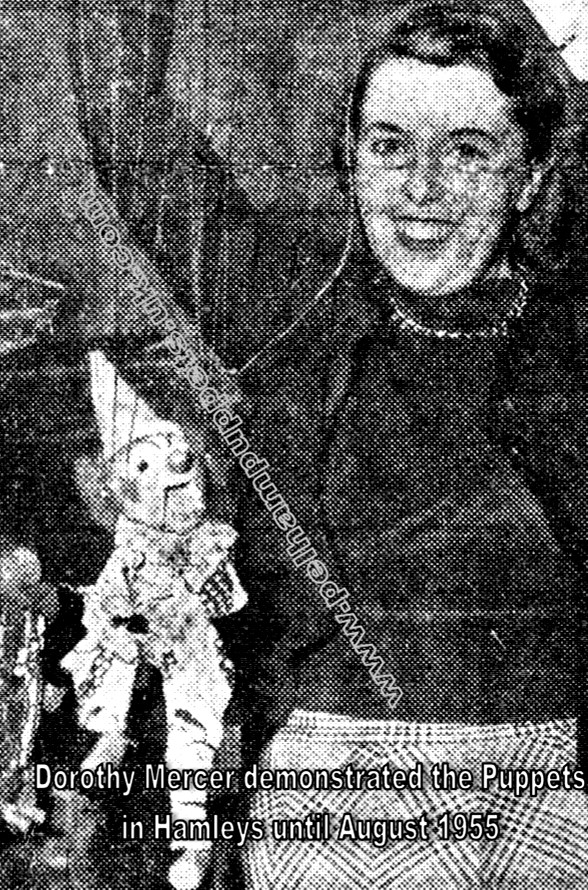 I returned home with enough money to pay all my debts and wages. But I had to remain in Marlborough and get on with production with renewed vigour. Our stocks were depleted, and everyone was very happy – the battle had been won. But sales had to continue, so for a while, Mary Rose Thesiger was employed as the puppet demonstrator. After I came back to Marlborough, Dorothy Mercer volunteered to go up to London to continue with the demonstrations for a few weeks. “She liked it so much however,” recalled Bob, “she stayed there for seven years!”
I returned home with enough money to pay all my debts and wages. But I had to remain in Marlborough and get on with production with renewed vigour. Our stocks were depleted, and everyone was very happy – the battle had been won. But sales had to continue, so for a while, Mary Rose Thesiger was employed as the puppet demonstrator. After I came back to Marlborough, Dorothy Mercer volunteered to go up to London to continue with the demonstrations for a few weeks. “She liked it so much however,” recalled Bob, “she stayed there for seven years!”
“After my success in Hamley’s, puppet sales mounted and of course, I had to expand but it wasn’t just as easy as that. Other shops had to be persuaded to accept and demonstrate them. In this respect a great deal of hard work was put into their promotion by William Seelig in London.” It was while Dot Mercer was demonstrating the puppets to an audience of children in Hamley’s that William Seelig arrived on the scene. He was not only fascinated by the puppets himself; he also saw how quickly the children were able to pick up the basic principles of operating the puppets. Being a man of considerable insight, he realised there would be a great future for them. It was only a matter of days afterwards that a friend introduced him to Bob. It did not take long for them to agree to co-operate and William took on the task of marketing the puppets throughout the British Isles, except for Lancashire where Bob had given the agency to Eric Broom.
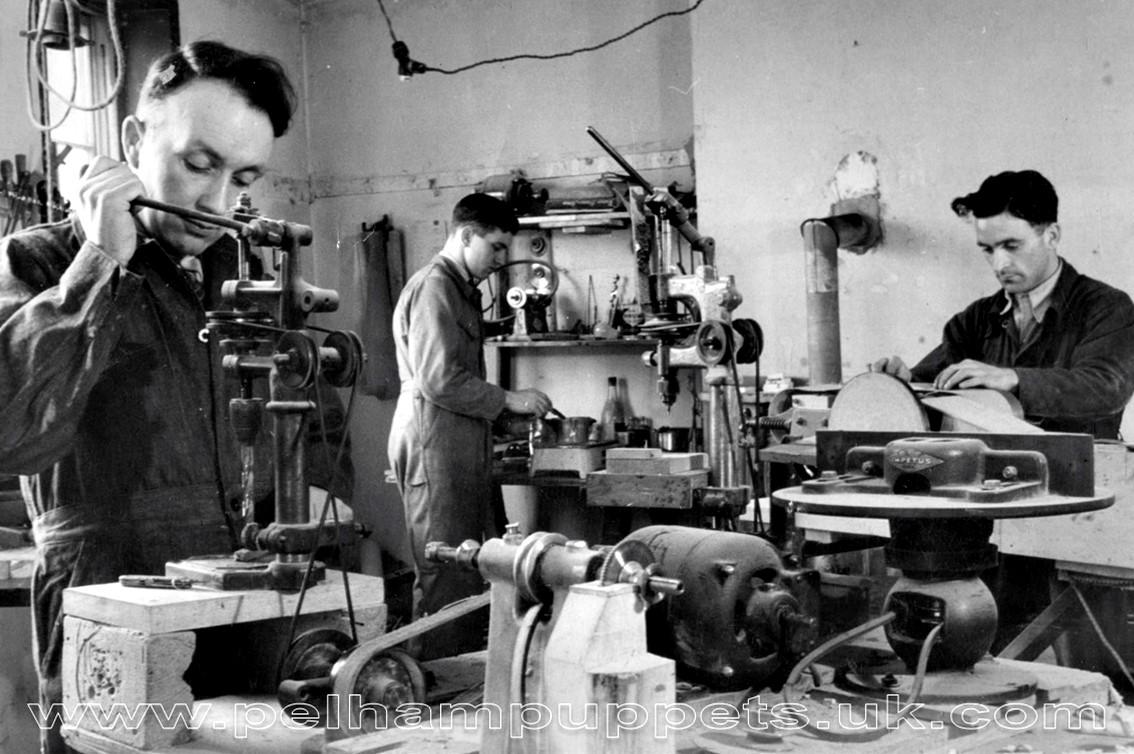 As business continued to improve, Bob recruited extra staff and Ken Hurll, a local fencing contractor, who had a lot of contacts throughout the country through his business, also assisted Bob with the business side of things. Ken only stayed with the company for a short time, resigning in January 1950. “I had met Arthur Harrison who had retired to Marlborough from a successful business career in Ceylon. We became business partners after Ken left and Arthur assumed much of the responsibility for the commercial aspects of the firm, leaving me more time to concentrate on the design and creation of new characters.”
As business continued to improve, Bob recruited extra staff and Ken Hurll, a local fencing contractor, who had a lot of contacts throughout the country through his business, also assisted Bob with the business side of things. Ken only stayed with the company for a short time, resigning in January 1950. “I had met Arthur Harrison who had retired to Marlborough from a successful business career in Ceylon. We became business partners after Ken left and Arthur assumed much of the responsibility for the commercial aspects of the firm, leaving me more time to concentrate on the design and creation of new characters.”
The photograph shows Frank Clements on the sand paper machine, (right) while Sidney Hiscock (left) is drilling holes and Maurice Roff (centre) has a saucepan of molten lead that would go to make up the hands for the puppets.
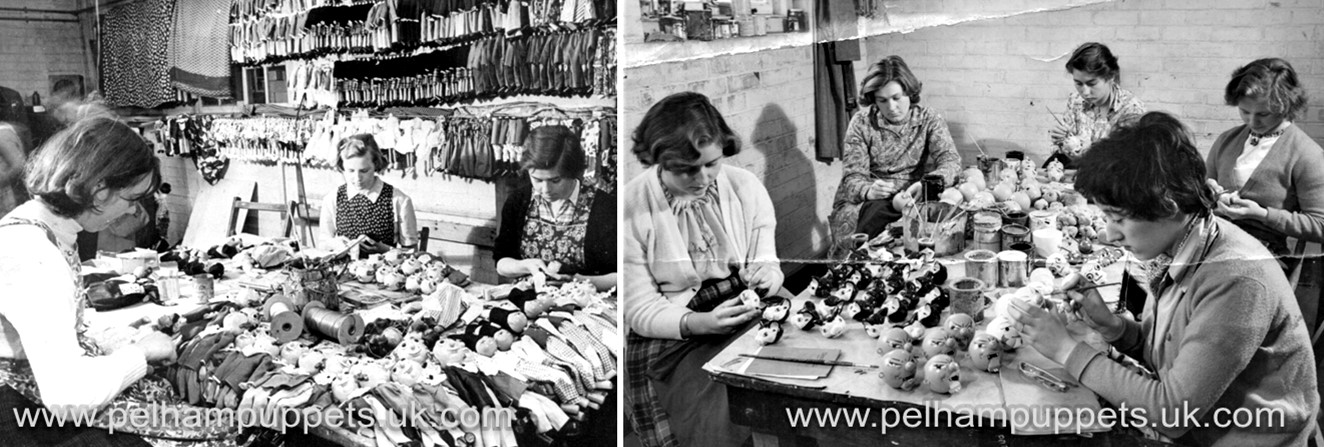
Photographs from 1954 showing the dressing room and head painter’s room.

Photo above: Left, Type SM puppets including the Policeman, Mrs O’Blige and Sandy MacBoozle; right: Type SL puppets including Mr Turnip and Sarah Swede and Disney characters, Pinocchio, Mickey & Minnie Mouse 1953.

Above: In the early 1950’s a whole range of glove puppets were produced, including (left,) Type SM puppets with moving mouths. A set of Punch & Judy puppets, Santa, pirates, animals and dwarfs were produced in the Type SL range too.

Above: A sales leaflet from the early 1950’s. Below: The images enlarged.

The animal range of puppets proved very popular, Gill Leeper helps with some of the designs such as the Parrot and the Duck. The Stage and scenes were added and even a record “with tunes specially composed for the puppets.”
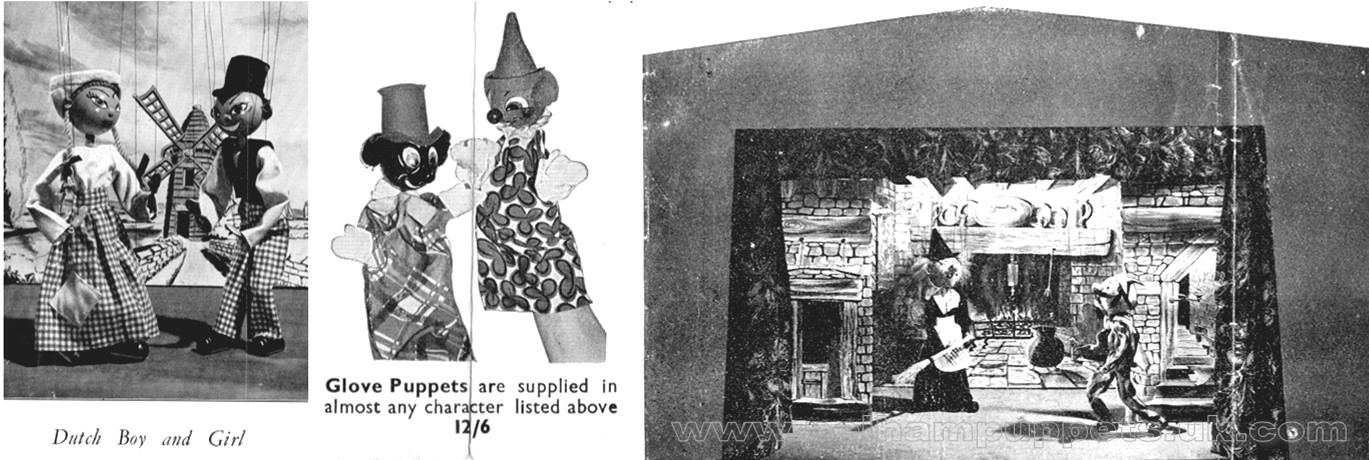
By 1952, the popularity of Pelham Puppets had grown to such an extent that it became clear that more space was going to be needed to manufacture them. The existing premises became too small for all the people who were now employed, so a larger, temporary, site was found in Elcot Lane on the outskirts of town. Bob recalled the need for larger premises with me in 1978:
“There were some old Nissen Huts in Elcot Lane left over from the war. So, we moved the main production line into these, but I kept the company offices and shop in Kingsbury Street. About a year later, I think it was, everything was brought together into the factory here and we’ve been here now for over 25 years.”
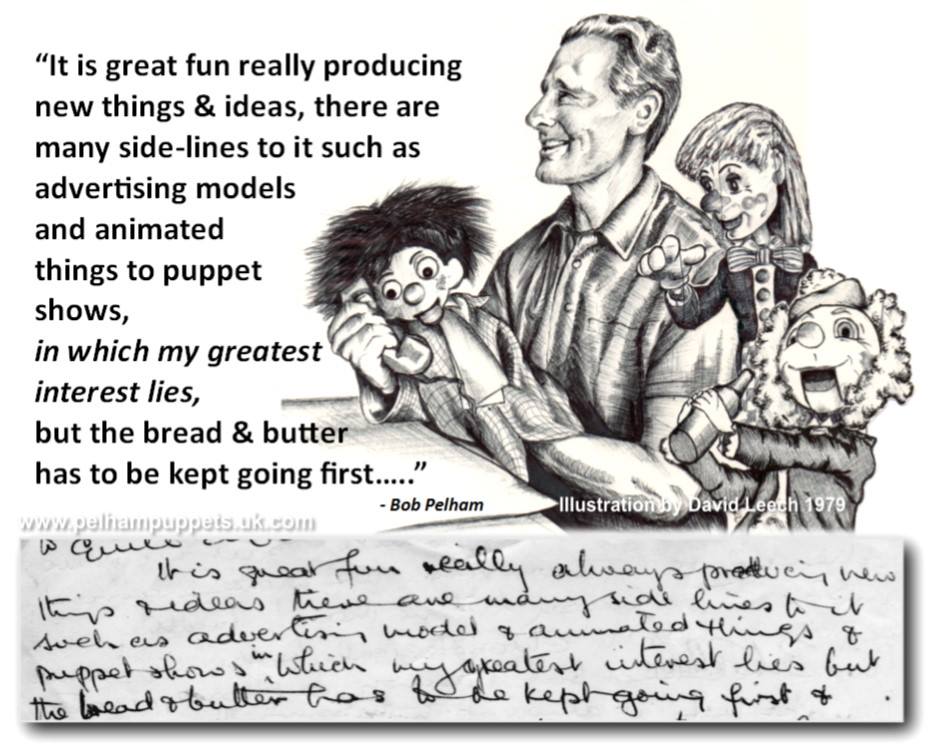 In August 1954, Bob, writing to a former war-time friend, said: “I really couldn’t relate chronological happenings since I was demobbed, but I am now a puppet – or rather, I make them. It amounts to the same thing! I have about 70 workers and perhaps 100 outworkers and we produce about 2,000 puppets a week and they go out to all parts of the world…. My wife and I run a club, the Pelpup Club. She deals with all the correspondence and I produce a magazine on a duplicator, about 1,500 copies each month. It gets a bit tedious after 42 months without a break. I never know what to put in next month’s, but it always comes – so far! – I have a partner who runs the business side of the firm which, as you can imagine with that volume of sales amounts to quite a bit. It is great fun really always producing new things and ideas. There are many sides to it, such as advertising and animated things and puppet shows, in which my greatest interest lies but the bread & butter has to be kept going first. It was more a question of bread in the early days, the butter has only recently been showing and there will be no question of having it both sides for a very long time, though the firm, I think, has good prospects – contrary to many peoples’ beliefs at the outset.”
In August 1954, Bob, writing to a former war-time friend, said: “I really couldn’t relate chronological happenings since I was demobbed, but I am now a puppet – or rather, I make them. It amounts to the same thing! I have about 70 workers and perhaps 100 outworkers and we produce about 2,000 puppets a week and they go out to all parts of the world…. My wife and I run a club, the Pelpup Club. She deals with all the correspondence and I produce a magazine on a duplicator, about 1,500 copies each month. It gets a bit tedious after 42 months without a break. I never know what to put in next month’s, but it always comes – so far! – I have a partner who runs the business side of the firm which, as you can imagine with that volume of sales amounts to quite a bit. It is great fun really always producing new things and ideas. There are many sides to it, such as advertising and animated things and puppet shows, in which my greatest interest lies but the bread & butter has to be kept going first. It was more a question of bread in the early days, the butter has only recently been showing and there will be no question of having it both sides for a very long time, though the firm, I think, has good prospects – contrary to many peoples’ beliefs at the outset.”
Throughout the 1950’s the steady progressive success of the company contributed greatly to the spirit of enthusiasm within the factory. Bob put forth continual efforts over the years to promote and maintain a happy spirit among his employees and he was always proud of the fact that he knew each one by name. It was easy to see the truthfulness of that for if it hadn’t been for the fact that most employees were women, it would have been difficult to point him out. Every day one could find him busy at a bench in a dust covered apron among them all!

The daily work could be very monotonous at times but these ladies knew how to have fun! Left to right: (1st Photo) Jesse Loney, Beryl Hawkins, Maggie Smart and Josie Rodda. (2nd Photo) Doris Birley, Iris Sheekey, Edith Cox and Dot Dooley. That’s Mr Pelham inside his large Bimbo costume at the Christmas party in 1962. (L to R) Fan Lanfear, Mrs Ross, Peter Carter-Page, Sid Long and Eileen Sims-Neighbour.
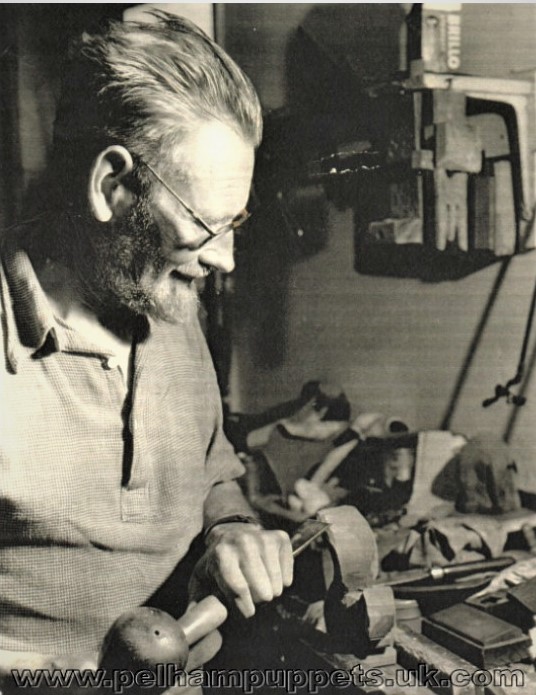 The company did branch out from regular lines of production by undertaking special work for the professional stage for many years. This is where Gil Leeper played a major part in the design and development of Pelham Puppets. Gil Leeper lived in an apartment on the top floor of Victoria House (where Bob Pelham occupied the ground and first floors for puppet production,) and he soon became familiar with the work that was going on in the floors below. He was a master wood carver and design artist. He first became involved with Pelham puppets when he offered to train the face painters to refine their work and helped to establish the traditional “Pelham look” to the faces of Pelham Puppets.
The company did branch out from regular lines of production by undertaking special work for the professional stage for many years. This is where Gil Leeper played a major part in the design and development of Pelham Puppets. Gil Leeper lived in an apartment on the top floor of Victoria House (where Bob Pelham occupied the ground and first floors for puppet production,) and he soon became familiar with the work that was going on in the floors below. He was a master wood carver and design artist. He first became involved with Pelham puppets when he offered to train the face painters to refine their work and helped to establish the traditional “Pelham look” to the faces of Pelham Puppets.
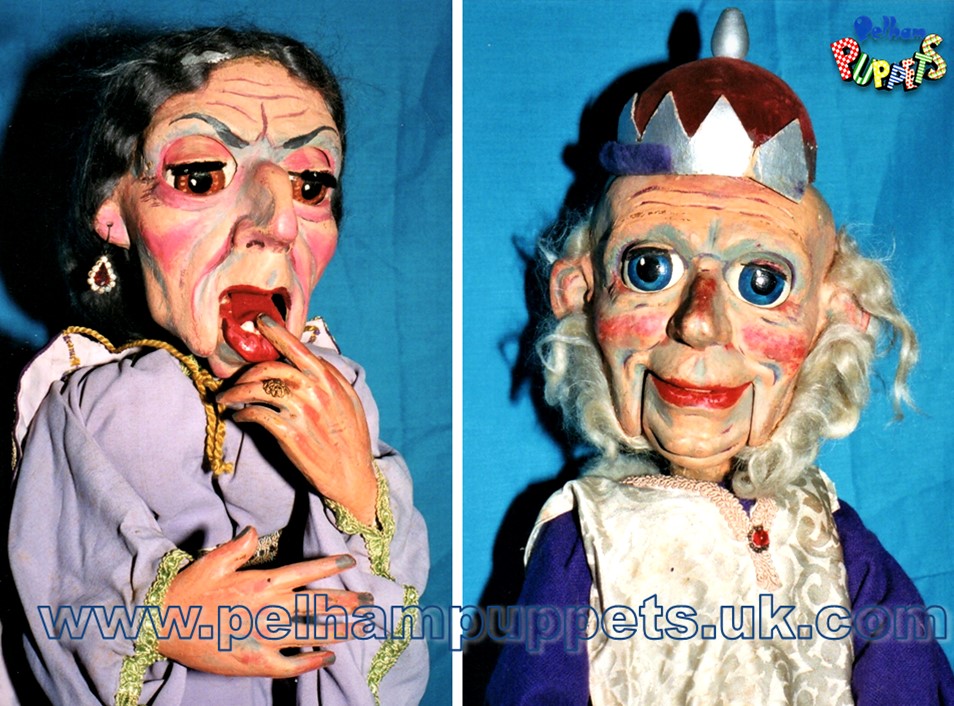 Later he was responsible for producing, with infinite care, some of the heads for the Type SL some characters from the original Cinderella series and Alice in wonderland characters as well as larger, professional puppets for use in theatre, film and television. His designs and work is very distinctive and is easily recognised by the caricatured, exaggerated and pronounced features, such as shown in the accompanied photographs of the two Ugly sisters and characters from “New King Coke” – that were commissioned for the production of an advertising film for British Gas Board.
Later he was responsible for producing, with infinite care, some of the heads for the Type SL some characters from the original Cinderella series and Alice in wonderland characters as well as larger, professional puppets for use in theatre, film and television. His designs and work is very distinctive and is easily recognised by the caricatured, exaggerated and pronounced features, such as shown in the accompanied photographs of the two Ugly sisters and characters from “New King Coke” – that were commissioned for the production of an advertising film for British Gas Board.
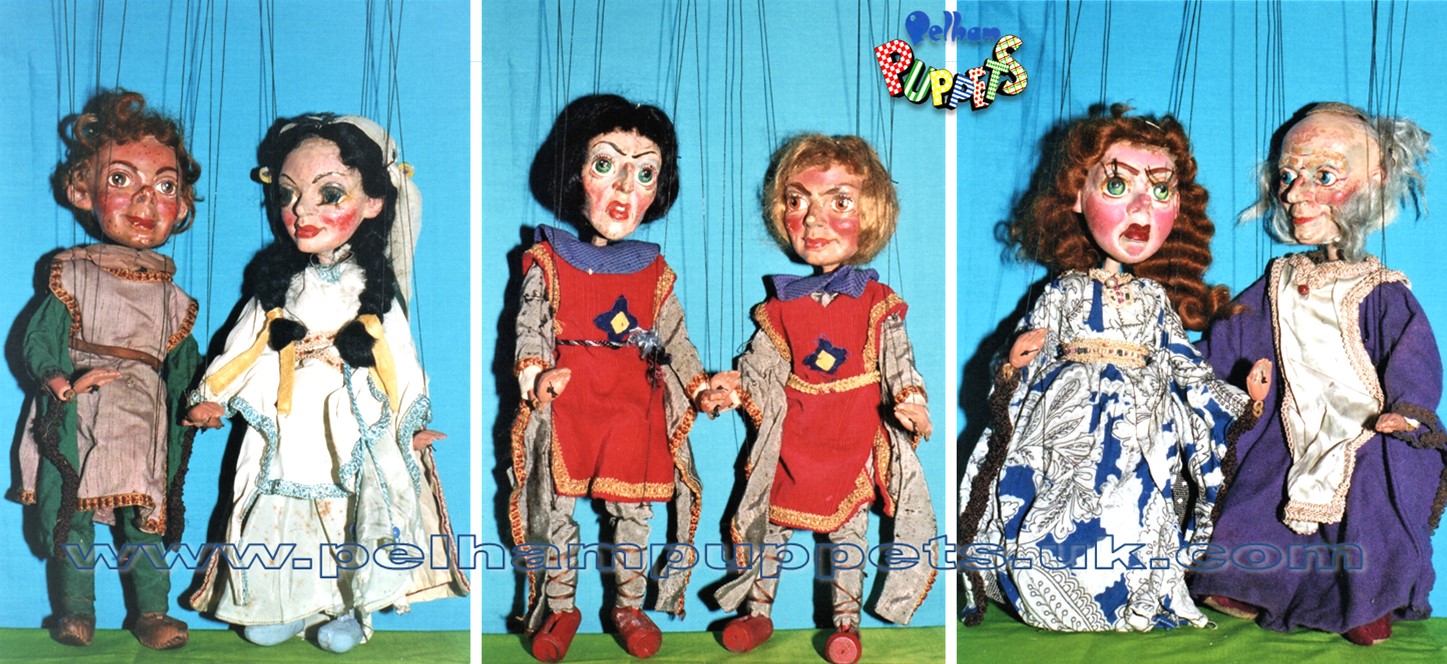
Above: Some of the cast from the New King Coke film. Below: the Ugly Sisters and prince Charming.
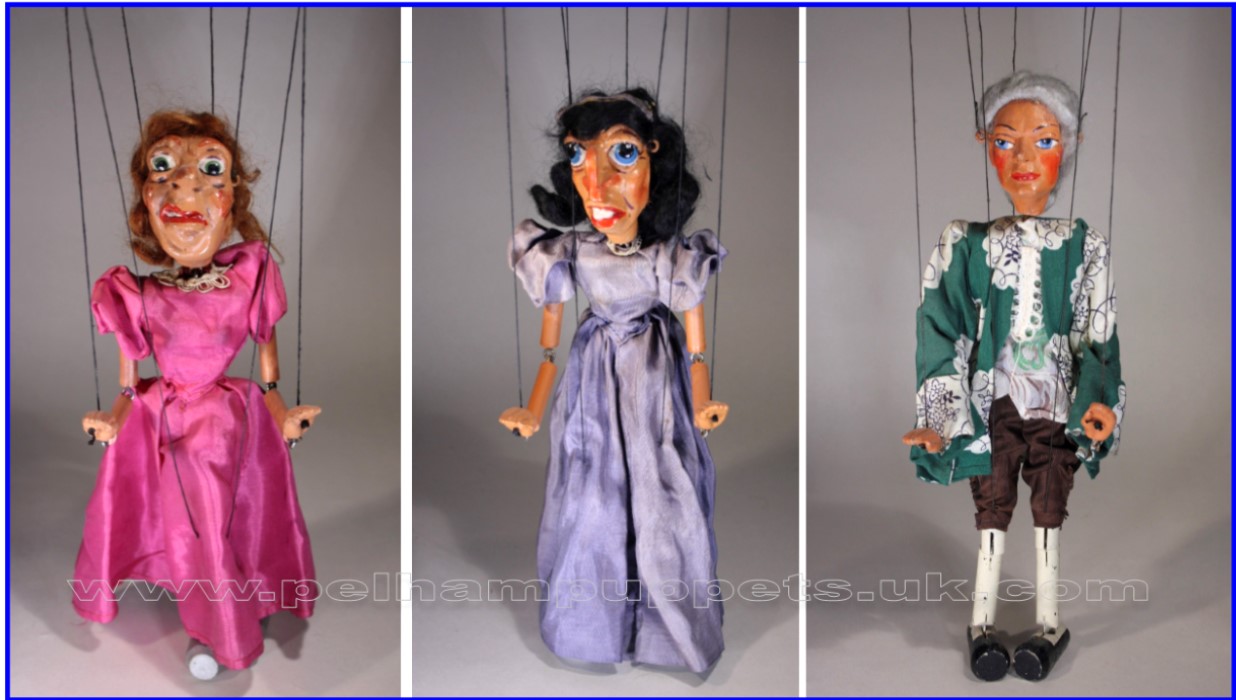
In the 1950s, the new medium of television was making an impact and puppets were frequently featured on the BBC and the ITV networks. Many puppet characters from children’s TV programmes were produced under license and some proved more successful than others. The first Pelham Puppet of a TV character was Mr Turnip followed by many others throughout the 1950’s, including The Bookworm Family, Muffin the Mule, Enid Blyton’s Noddy, Torchy the Battery Boy, Twizzle and a whole range characters from Disney films too.
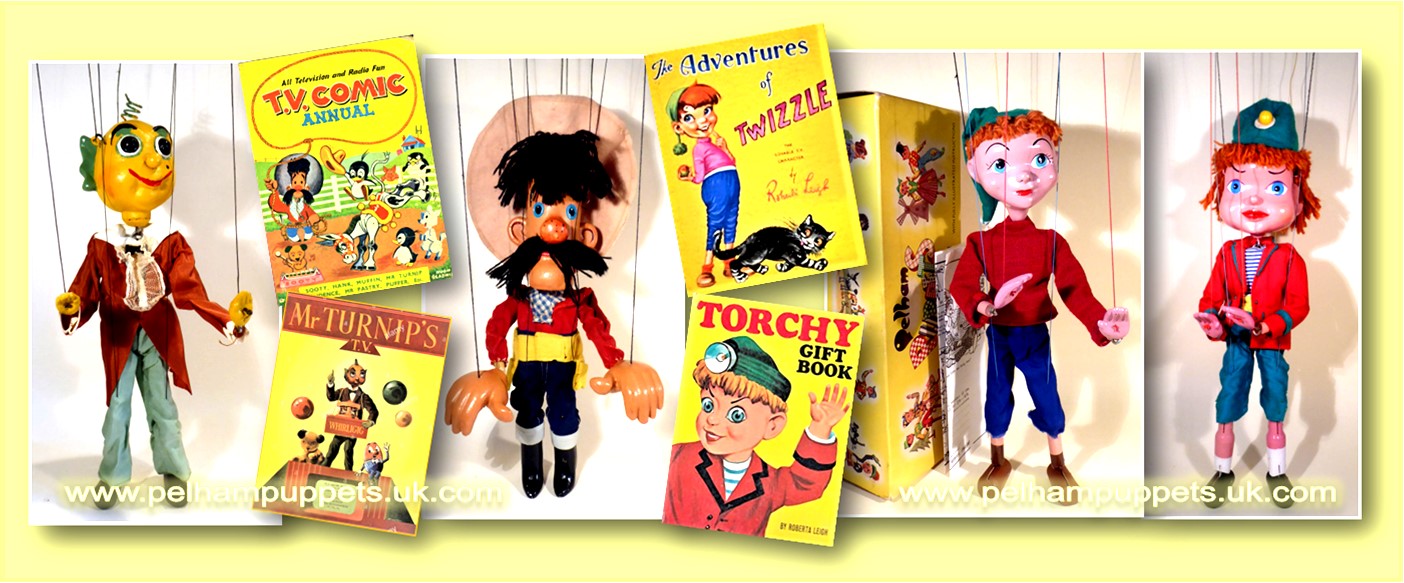
Above: Mr Turnip, Hank, Twizzle and Torchy.

Above: Noddy & Big ears, (Type SS and Type SL) Muffin, Davy Crockett
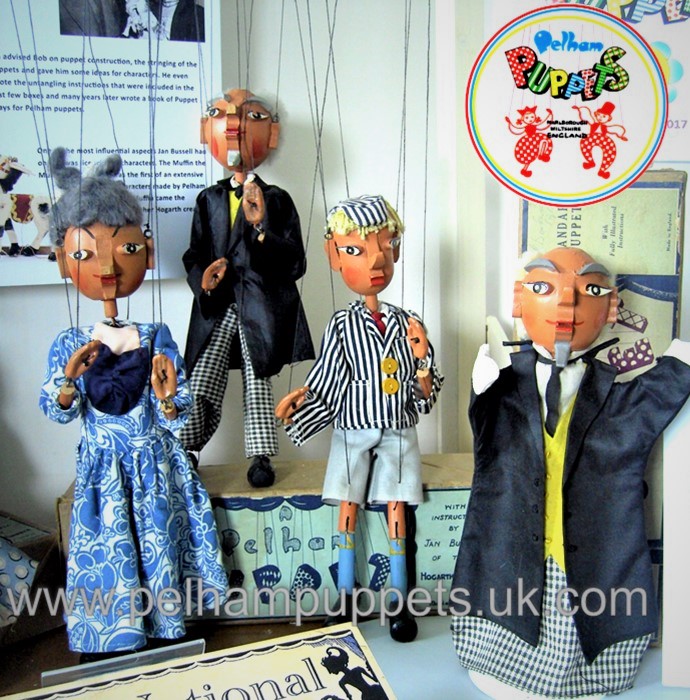 The Bookworm Family that followed in the footsteps of Muffin the Mule were all creations of Ann Hogarth and Jan Bussell. Jan moved to Marlborough at the age of six and attended Marlborough College. It was here that he met Bob Pelham and since he lived only a short waking distance from Victoria House (in St Martin’s Road,) he was a frequent visitor to the Pelham manufacturing base when he was not on tour with the Hogarth Puppets. The Bookworm Family first appeared in television in February 1951 and it was from this time that Bob added the characters to his ever increasing range of puppet characters.
The Bookworm Family that followed in the footsteps of Muffin the Mule were all creations of Ann Hogarth and Jan Bussell. Jan moved to Marlborough at the age of six and attended Marlborough College. It was here that he met Bob Pelham and since he lived only a short waking distance from Victoria House (in St Martin’s Road,) he was a frequent visitor to the Pelham manufacturing base when he was not on tour with the Hogarth Puppets. The Bookworm Family first appeared in television in February 1951 and it was from this time that Bob added the characters to his ever increasing range of puppet characters.
From 1955 a whole new department was created to produce an extensive range of life size puppets. This began with the creation of Bimbo the Clown and led to hundreds of other clowns, and versions of other characters already in production as well as life size animals, birds, pop singers and even a robot.
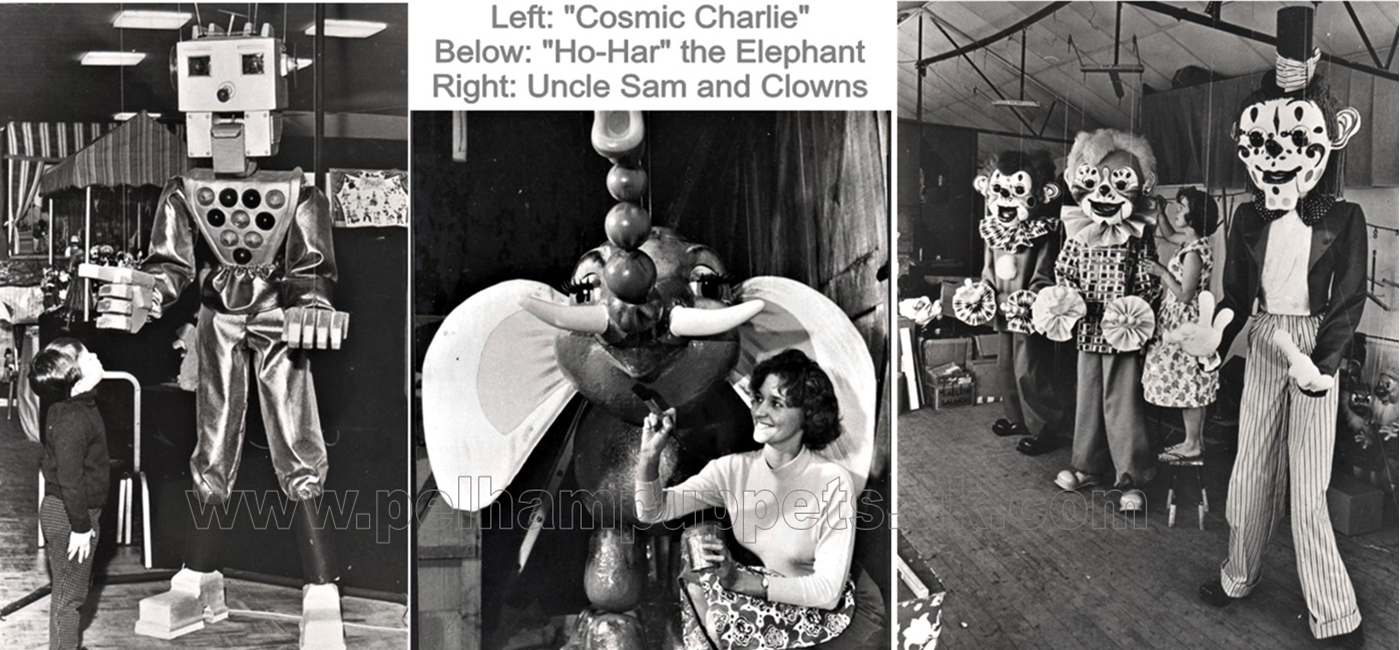 Above: “Cosmic Charlie” – the Robot with flashing lights and buzzing sounds was made in 1965 and made his debut at the Toy Fair in January 1966. Jenny Waite (nee: Shepherd) is pictured with “Ho-Ha!” the Elephant who made a loud trumpeting noise when he moved. Bob called him Ho-Har because, “That’s what I’d probably say to him if I met him in the Dark.” Uncle Sam and the Clowns seen on the right, were part of a large consignment of 100 larger than life size puppets destined for Chicago USA in 1957.
Above: “Cosmic Charlie” – the Robot with flashing lights and buzzing sounds was made in 1965 and made his debut at the Toy Fair in January 1966. Jenny Waite (nee: Shepherd) is pictured with “Ho-Ha!” the Elephant who made a loud trumpeting noise when he moved. Bob called him Ho-Har because, “That’s what I’d probably say to him if I met him in the Dark.” Uncle Sam and the Clowns seen on the right, were part of a large consignment of 100 larger than life size puppets destined for Chicago USA in 1957.
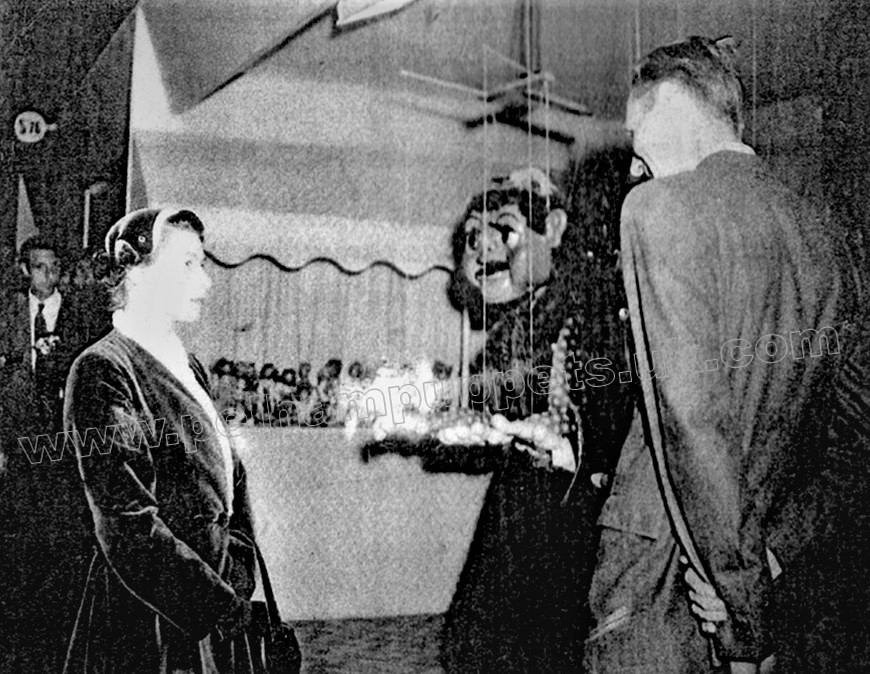 Royal Visitors – British Industries Fair May 1955
Royal Visitors – British Industries Fair May 1955
On May 10th 1955 the Queen and the Duke of Edinburgh visited the Pelham Puppets Stand at the British Industries fair. Bob recalled, “I was introduced to the Queen and Prince Philip and she asked me a number of questions about the puppets and when I began making them. Prince Philip also seemed greatly interested in the puppets and how they worked. After explaining to them both as best I could, the basic principles of operating the puppets and how to avoid getting the strings into a tangle, I asked the Queen whether she would like to see a puppet show. Her face lit up with a delighted smile and she said “Oh yes please!”
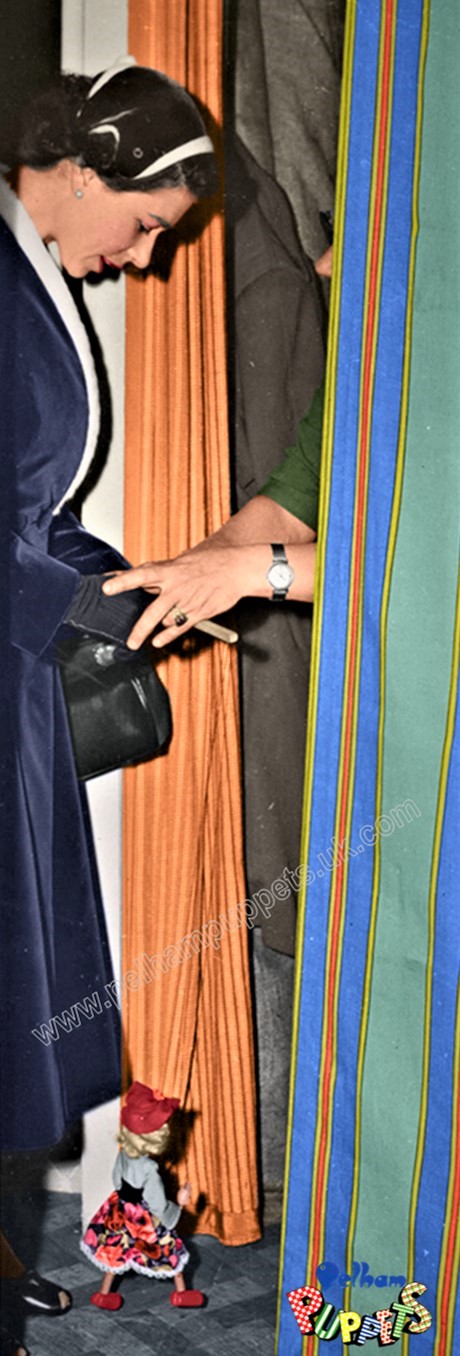 The scene was already set on the stage for ‘How much is that doggie in the window?’ so I slipped behind the stage, the curtains were drawn back and my show began. A few moments later I became aware that Prince Philip, who is always interested in knowing how things work, was standing beside me and watching me manipulate the puppets. He plied me with questions and I answered him while working the puppets, which kept me very much on my toes!
The scene was already set on the stage for ‘How much is that doggie in the window?’ so I slipped behind the stage, the curtains were drawn back and my show began. A few moments later I became aware that Prince Philip, who is always interested in knowing how things work, was standing beside me and watching me manipulate the puppets. He plied me with questions and I answered him while working the puppets, which kept me very much on my toes!
Before the act was over, the Queen herself came behind the stage and standing beside Mrs Allen, who was the demonstrator from Harrods, and who was helping me operate the puppets, asked her if the puppets were simple to operate. Mrs Allen replied by handing Mitzi to the Queen and after showing her how to hold the control, invited her to try for herself!
The Queen was enchanted and one of my most treasured possessions is a picture which the press took of the Queen holding the control of Mitzi, utterly enthralled as she finds that she is making the puppet walk across the floor in a most natural way.
The Queen was obviously delighted to find that working the puppet was really quite easy and not nearly as difficult as she thought it would be. I think that the Queen and the Duke both went away from the stand very happy and I hope that I was able to give them a little light relief during their busy and intensive tour of the fair.”
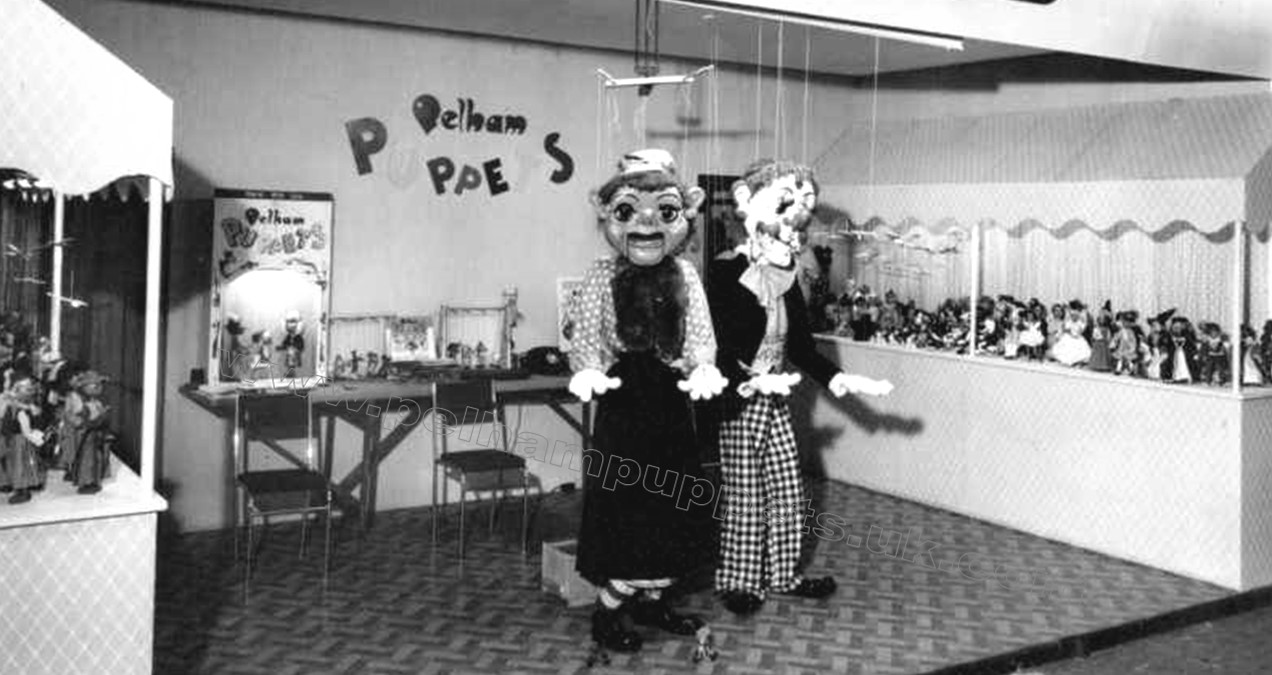
You can see some of the large puppets in action, including Bimbo, along with Bob Pelham showing a TV presenter around the factory in December 1959) here. (Not 1953 as stated in the video. Baby Bimbo seen near the end, didn’t appear until 1955 according to the Company Production Records.)
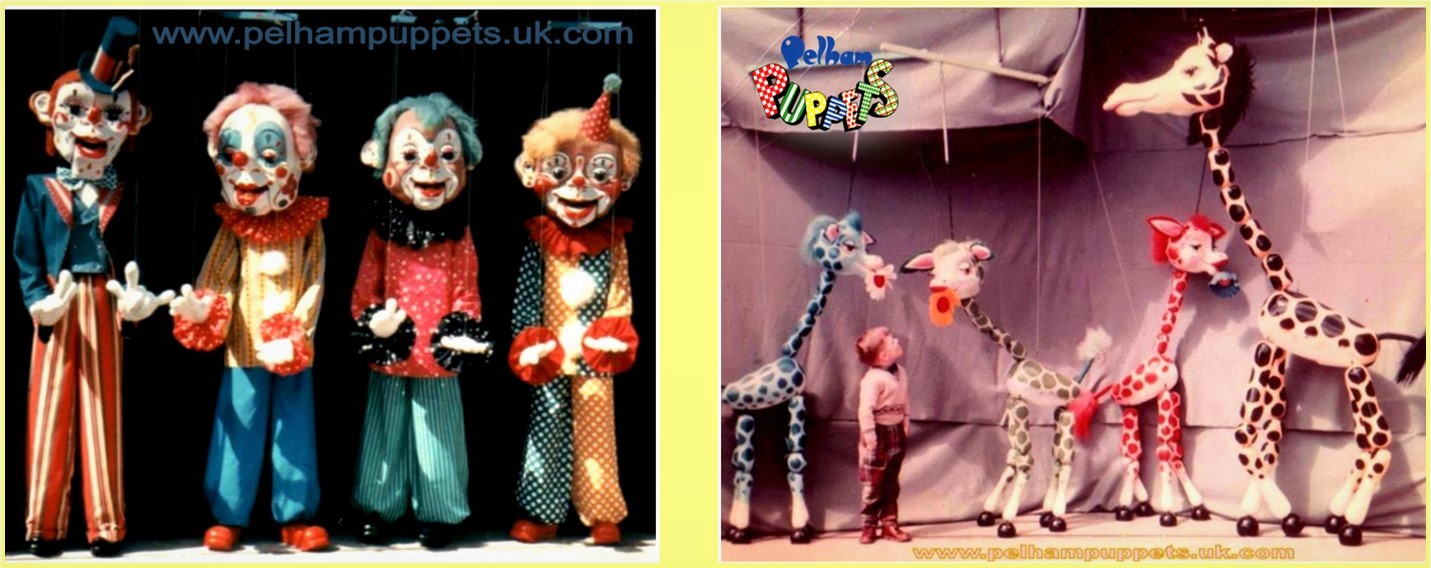
Above: Uncle Sam and the clowns, summer 1955 and the Giraffe family. The family of giraffes, first made in1958 were bought by the British Royal family and to this day, these puppets are on show in Windsor Castle.
Below: The employees responsible for the face painting and costumes with some of the large puppets; Maggie, Fan, Shirley, Pan, Dot, Bernice, Ann, Iris, Jessie and Joan – small ‘snap-shots’ from 1955.
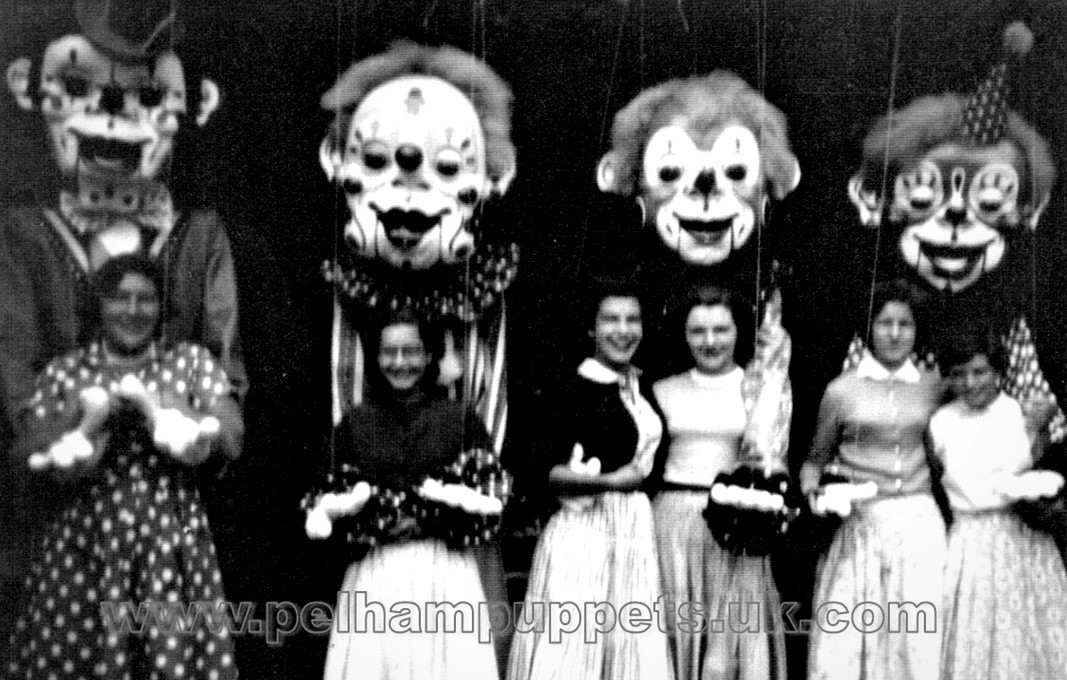
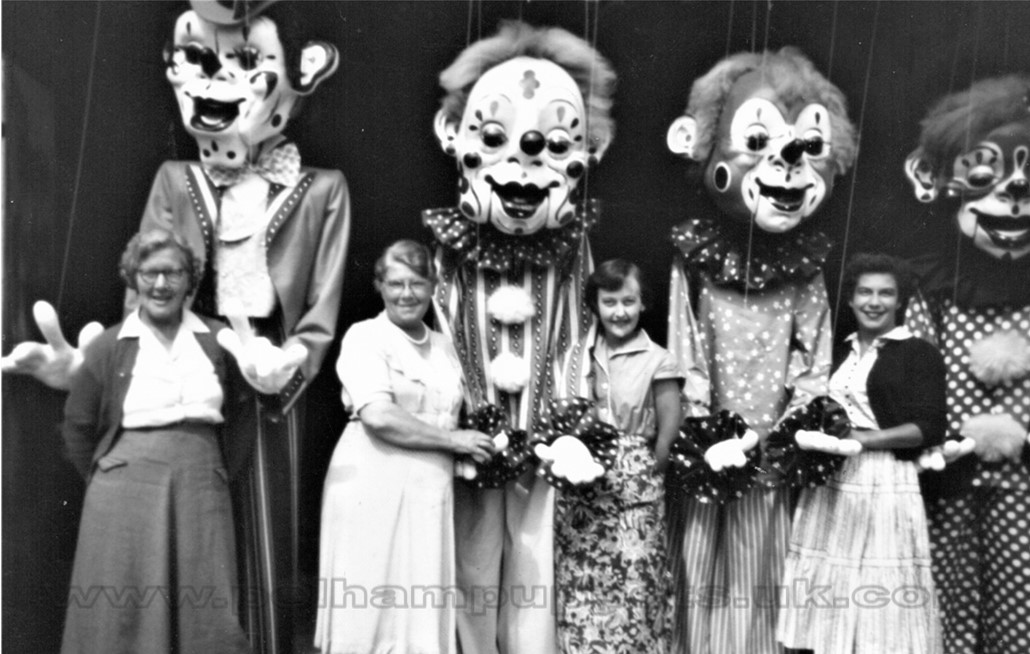
Below: A life size lady pop singer in January 1966 on display at the Brighton Toy Fair. Centre photo: Bob with a Tiger on his back in 1961. Right: Sid Long with a Lion, the mane for this giant Lion puppet was made out of a large tractor tyre!
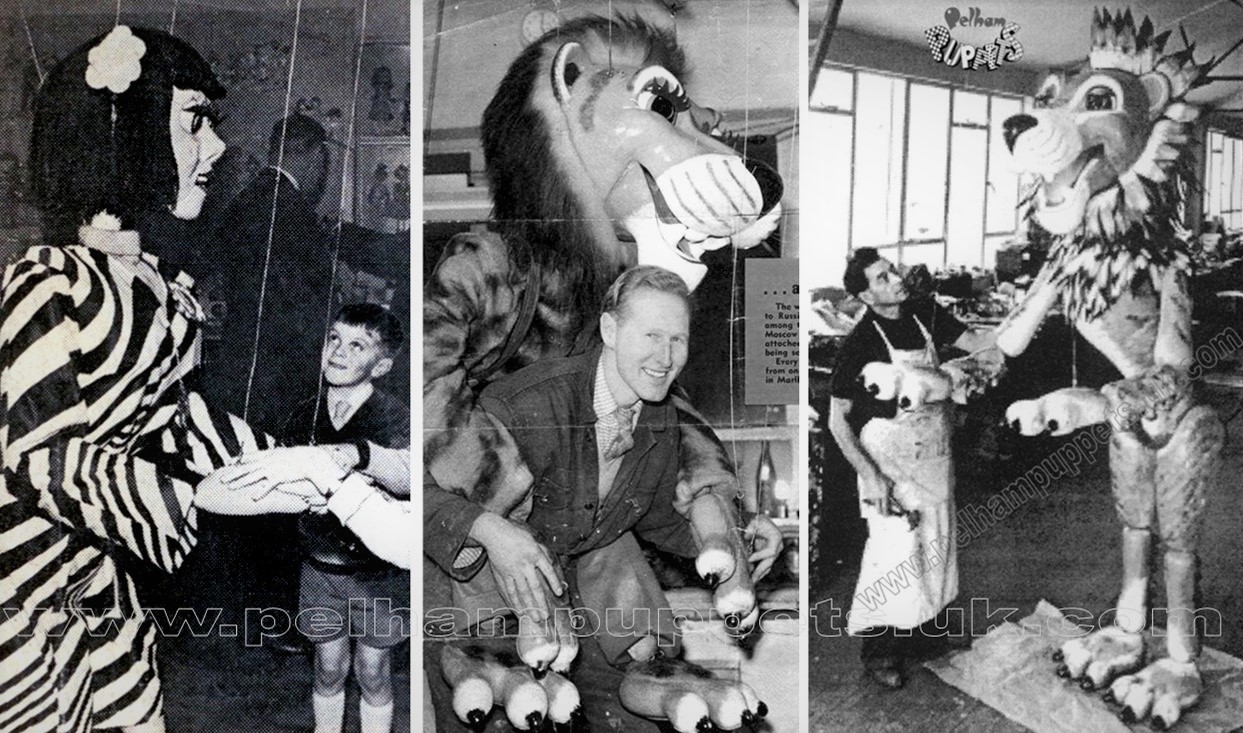
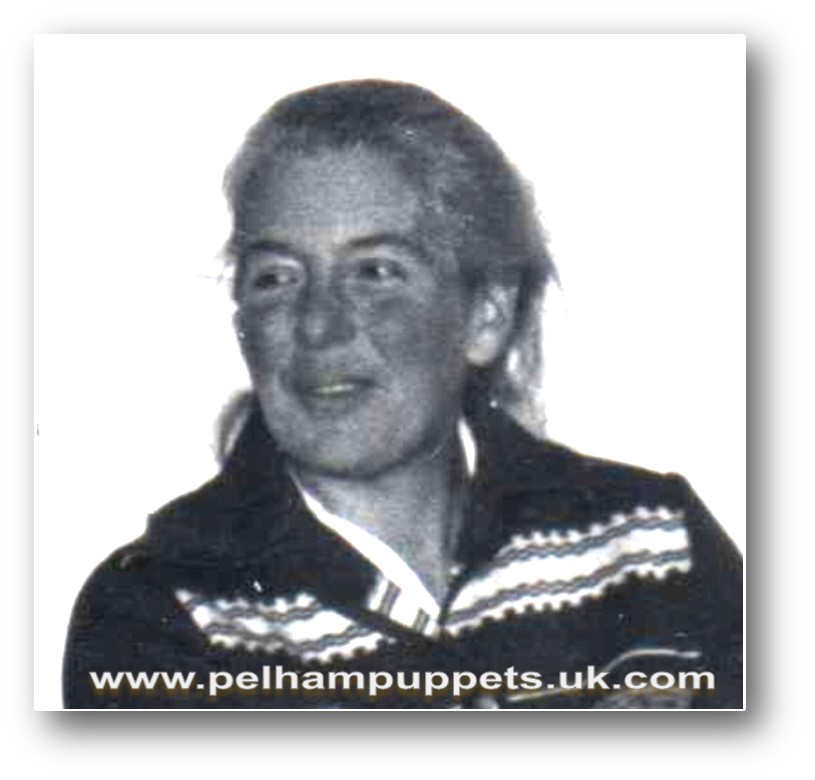 When Bob’s business partner, Arthur Harrison resigned in 1956, Anne and Bob had been married for four years and she became Company Co-Director. She also fulfilled another vital role over the years by calming many of Bob’s worries. He was an artist rather than a businessman and as such, the harsh realities of the world of commerce tended, on occasions to overcome him. In this, Anne proved her strength by smoothing away the problems, often showing him that his fears were groundless, or at worst, the normal expectations of commercial reality. As the years passed, so Anne contributed more and more to the running of the business. It became in every sense, a joint venture and when their children, Michael and Sarah, were born, a family affair. Could anything be more appropriate in a company making puppets for children?
When Bob’s business partner, Arthur Harrison resigned in 1956, Anne and Bob had been married for four years and she became Company Co-Director. She also fulfilled another vital role over the years by calming many of Bob’s worries. He was an artist rather than a businessman and as such, the harsh realities of the world of commerce tended, on occasions to overcome him. In this, Anne proved her strength by smoothing away the problems, often showing him that his fears were groundless, or at worst, the normal expectations of commercial reality. As the years passed, so Anne contributed more and more to the running of the business. It became in every sense, a joint venture and when their children, Michael and Sarah, were born, a family affair. Could anything be more appropriate in a company making puppets for children?
Part Two of the Story of Pelham Puppets continues HERE.
“PELPOP – The Story of Pelham Puppets” can be found in David’s book: PELHAM PUPPETS – A Collector’s Guide – published by Crowood Press (2008) IBSN 978-1-84797-055-8 and can be obtained from good booksellers, Ebay, Amazon etc.

